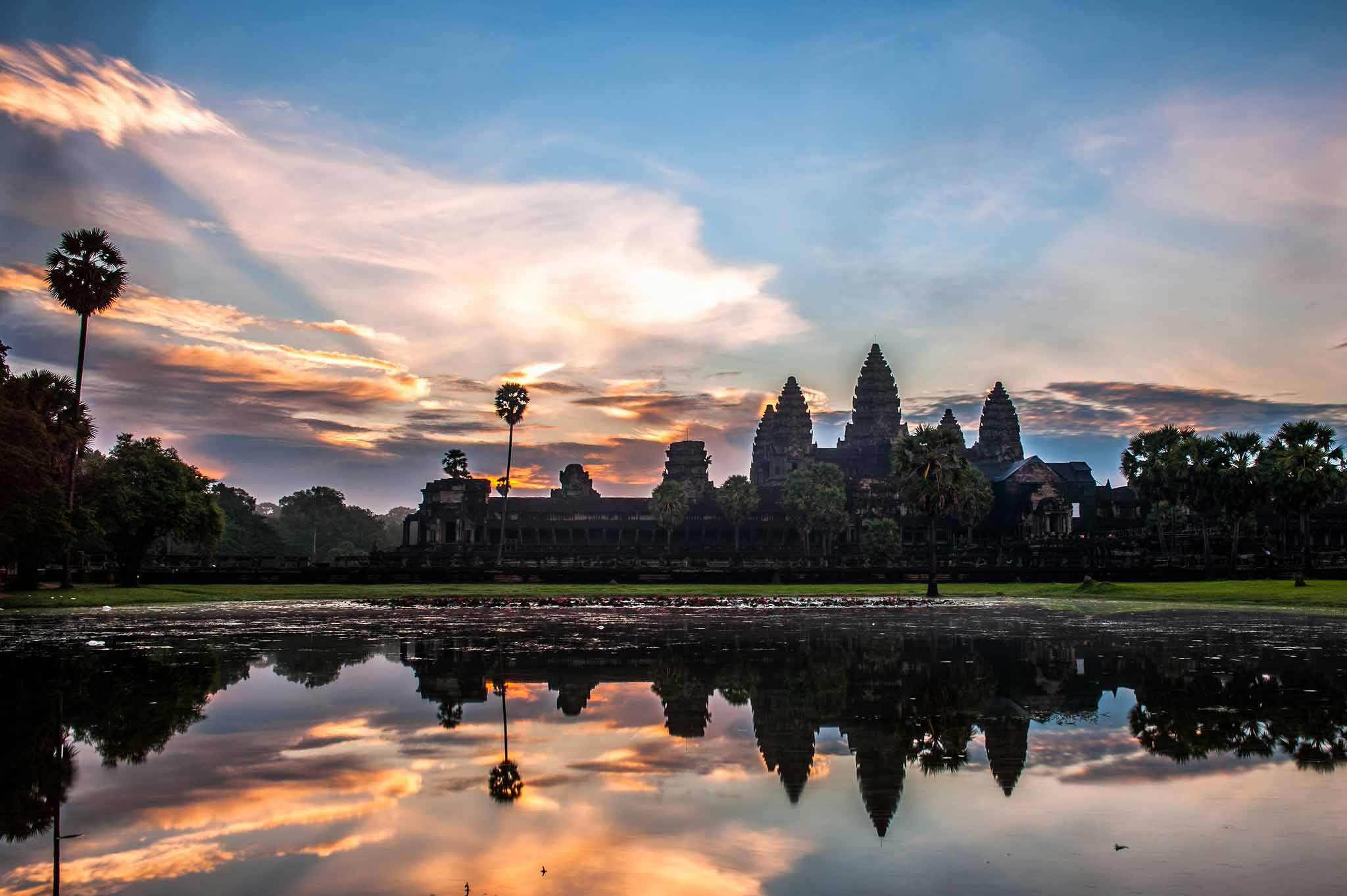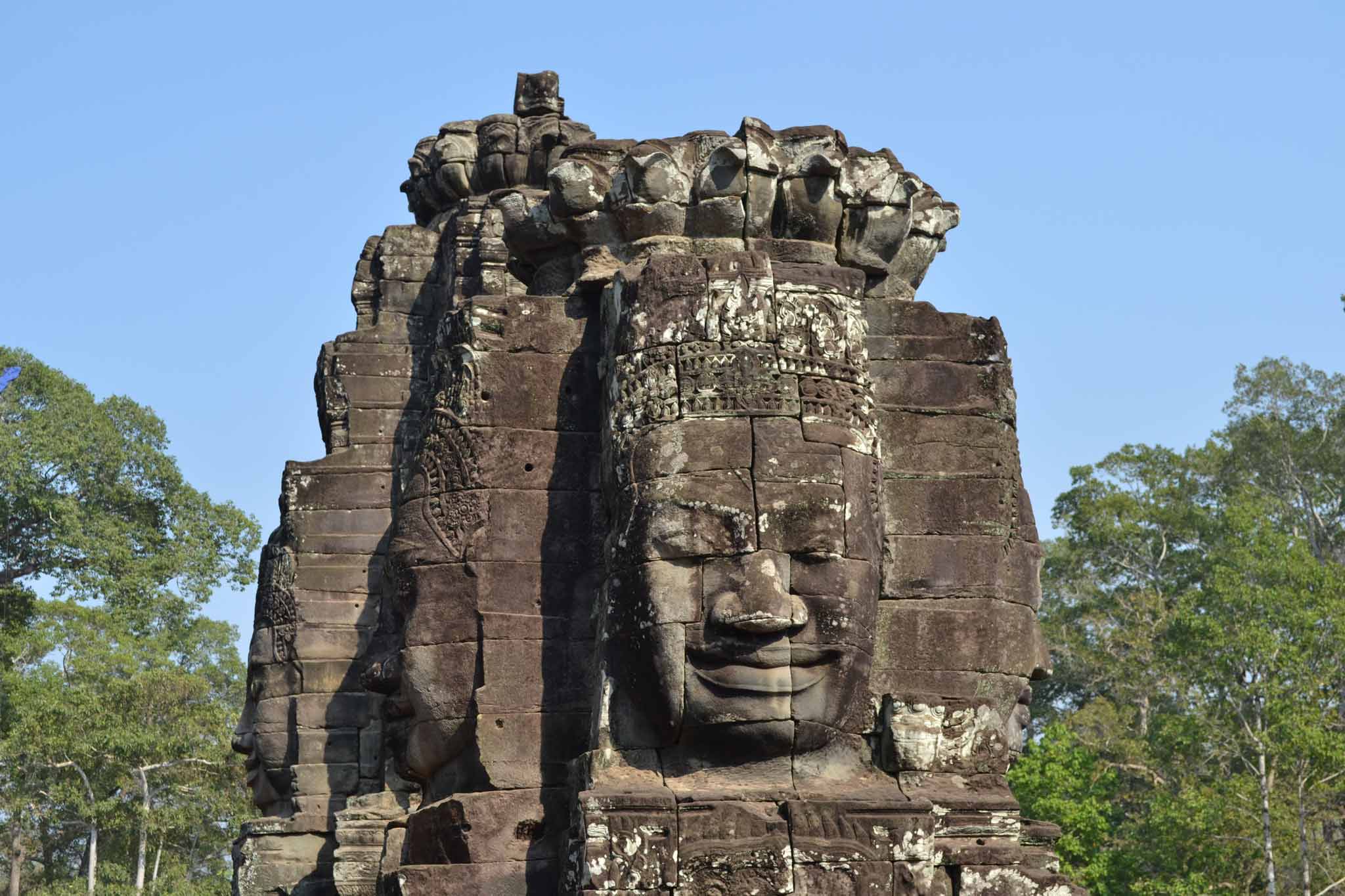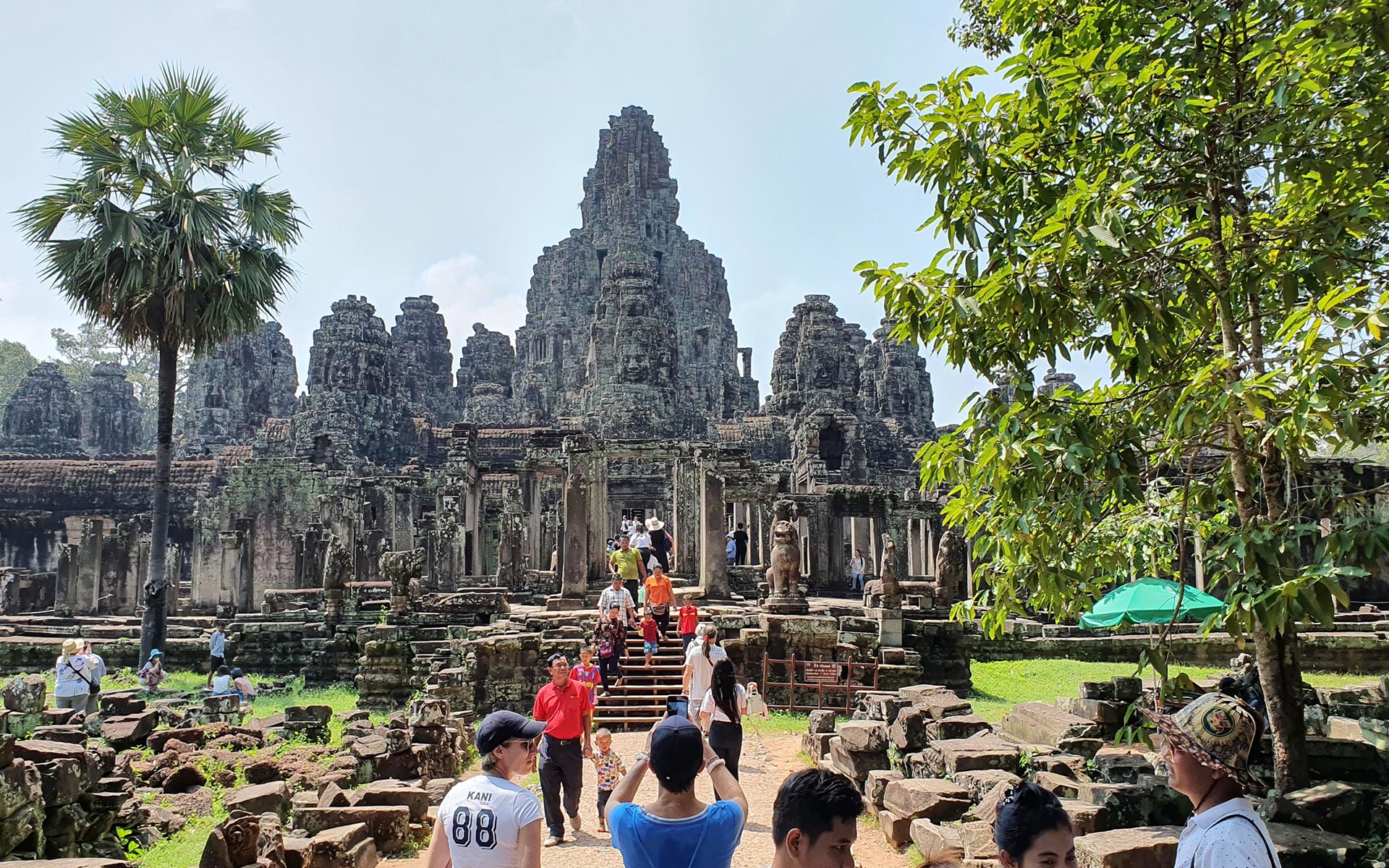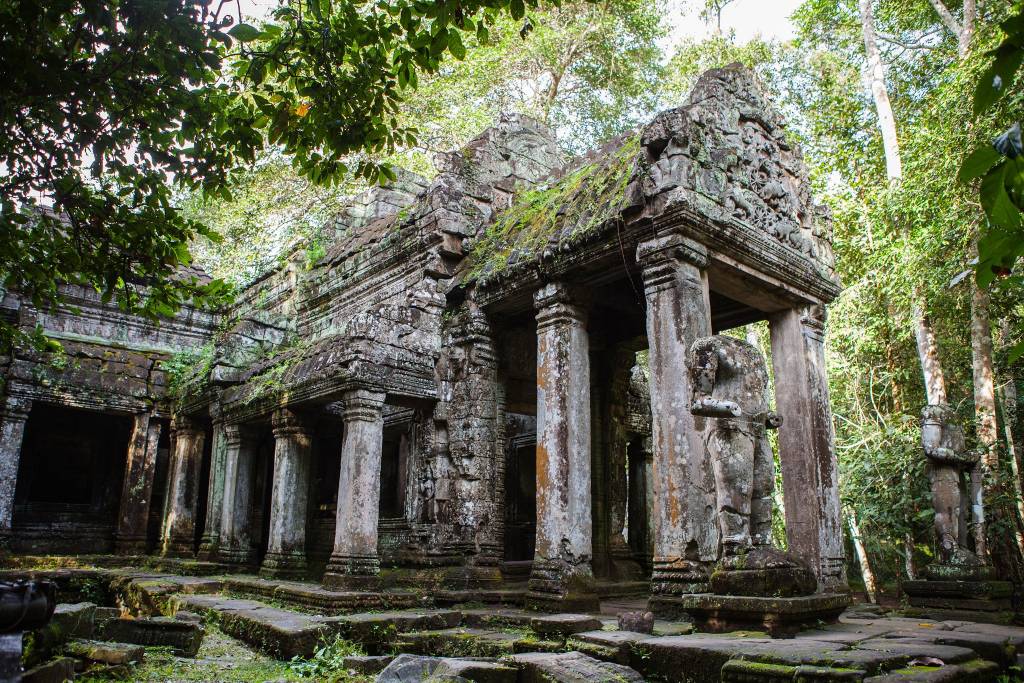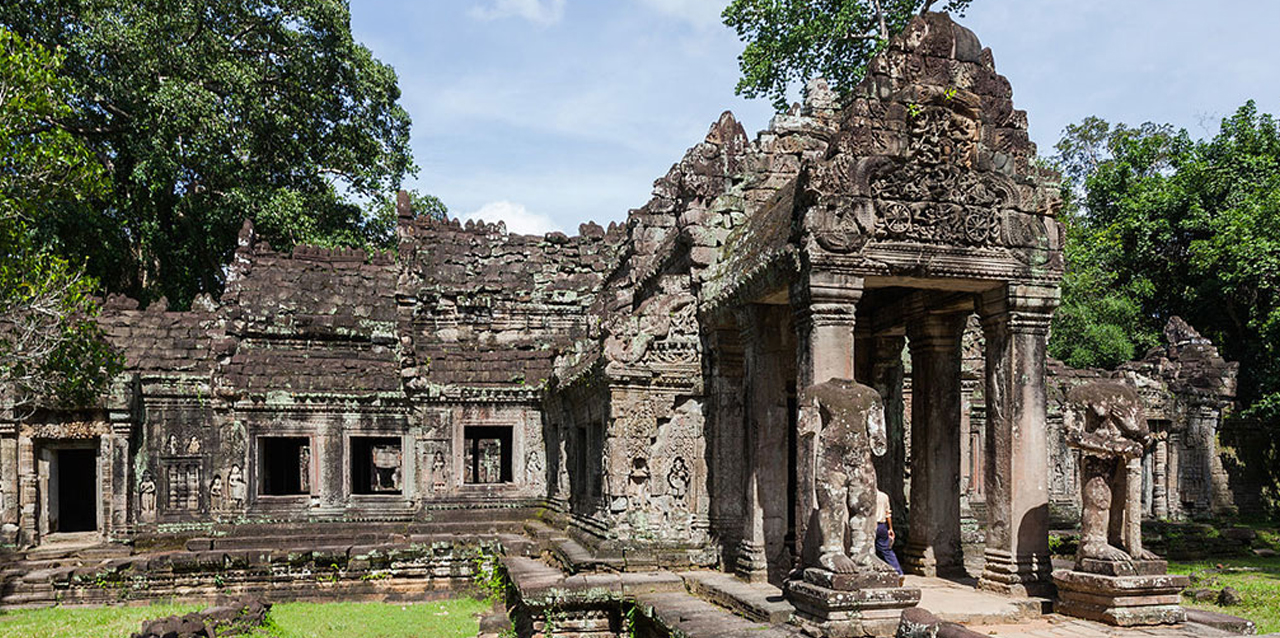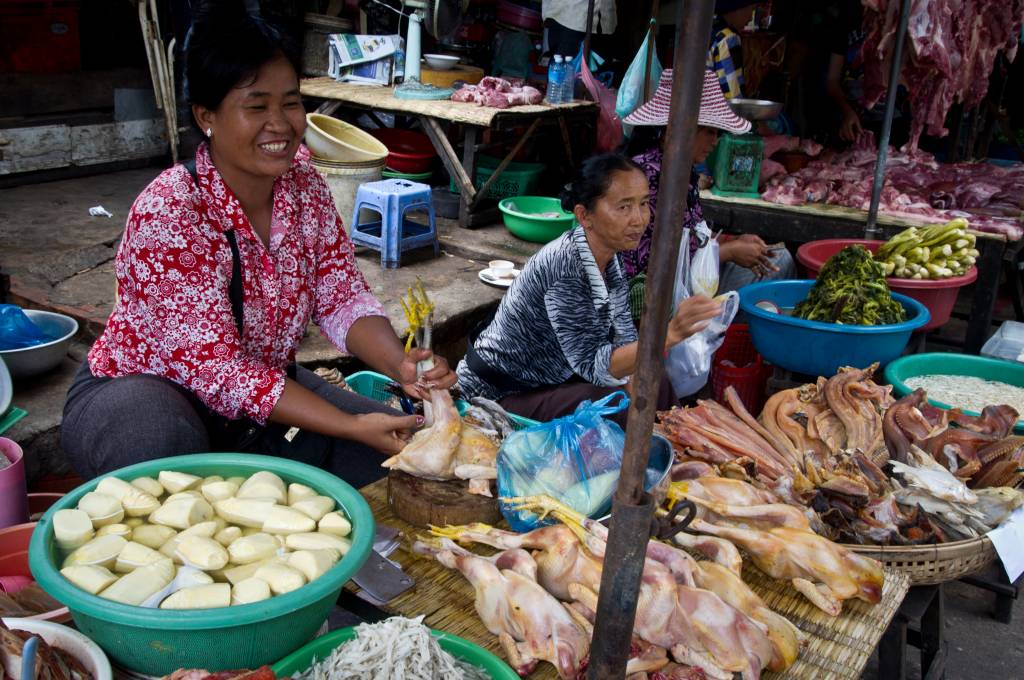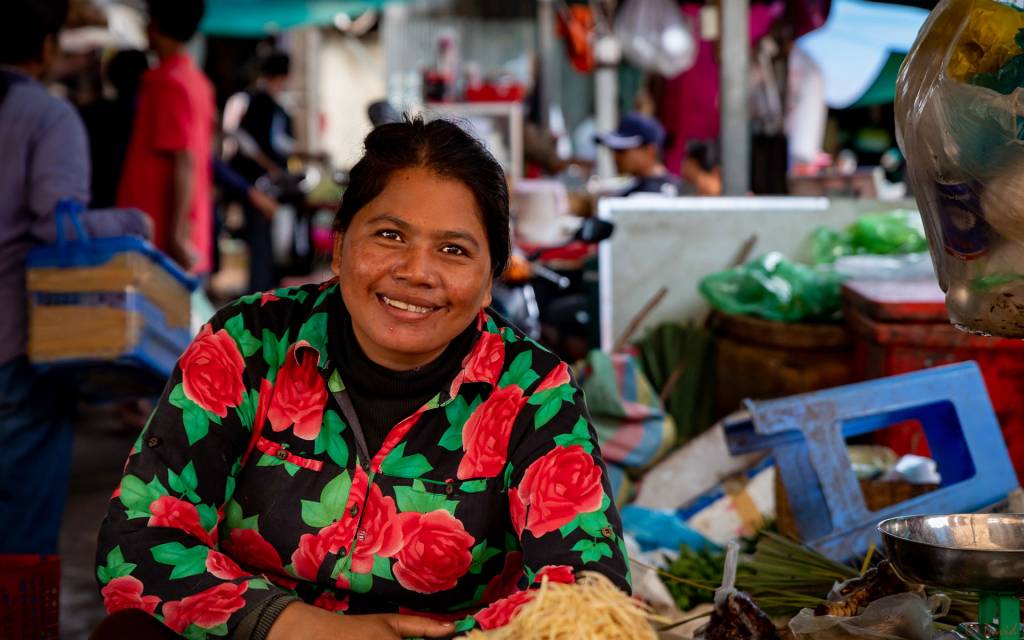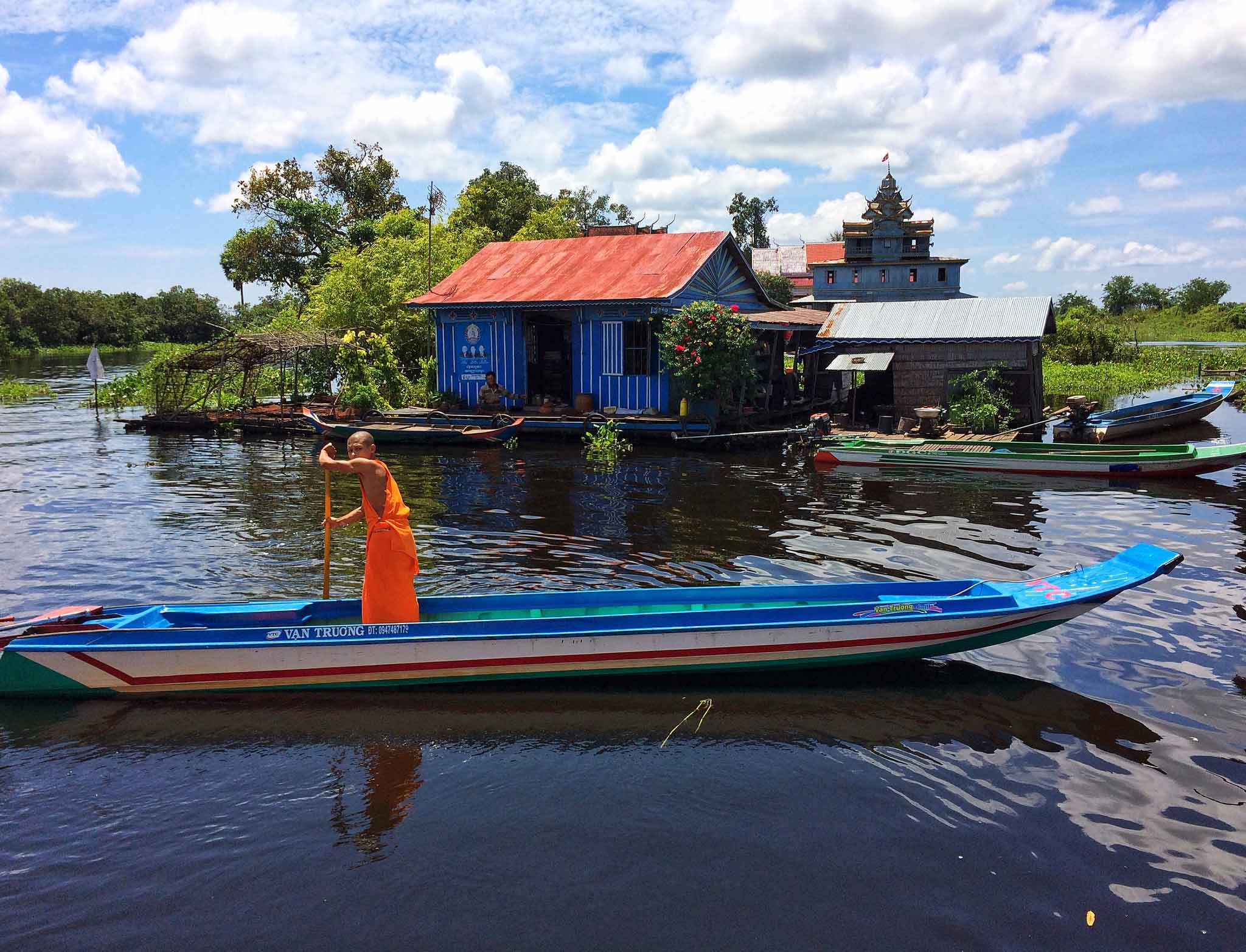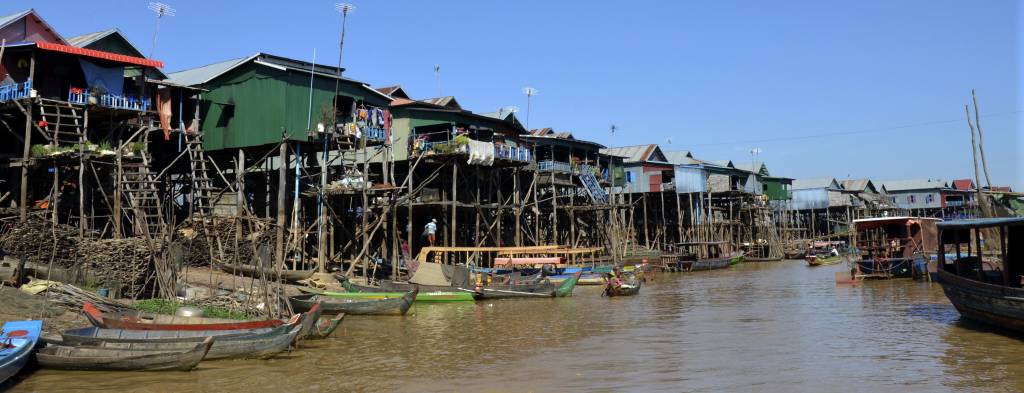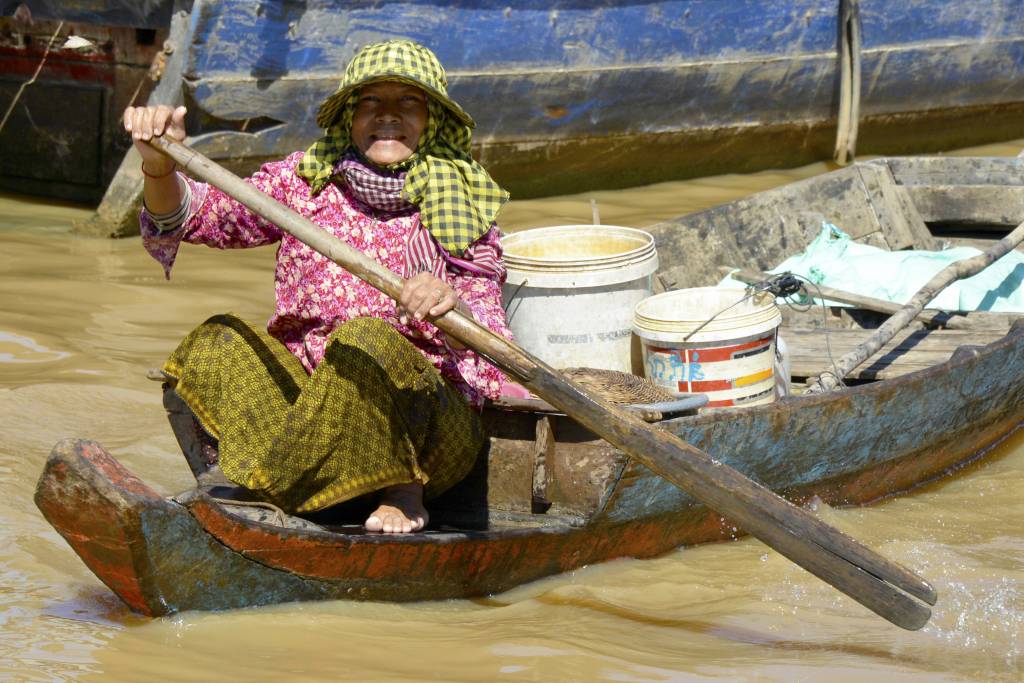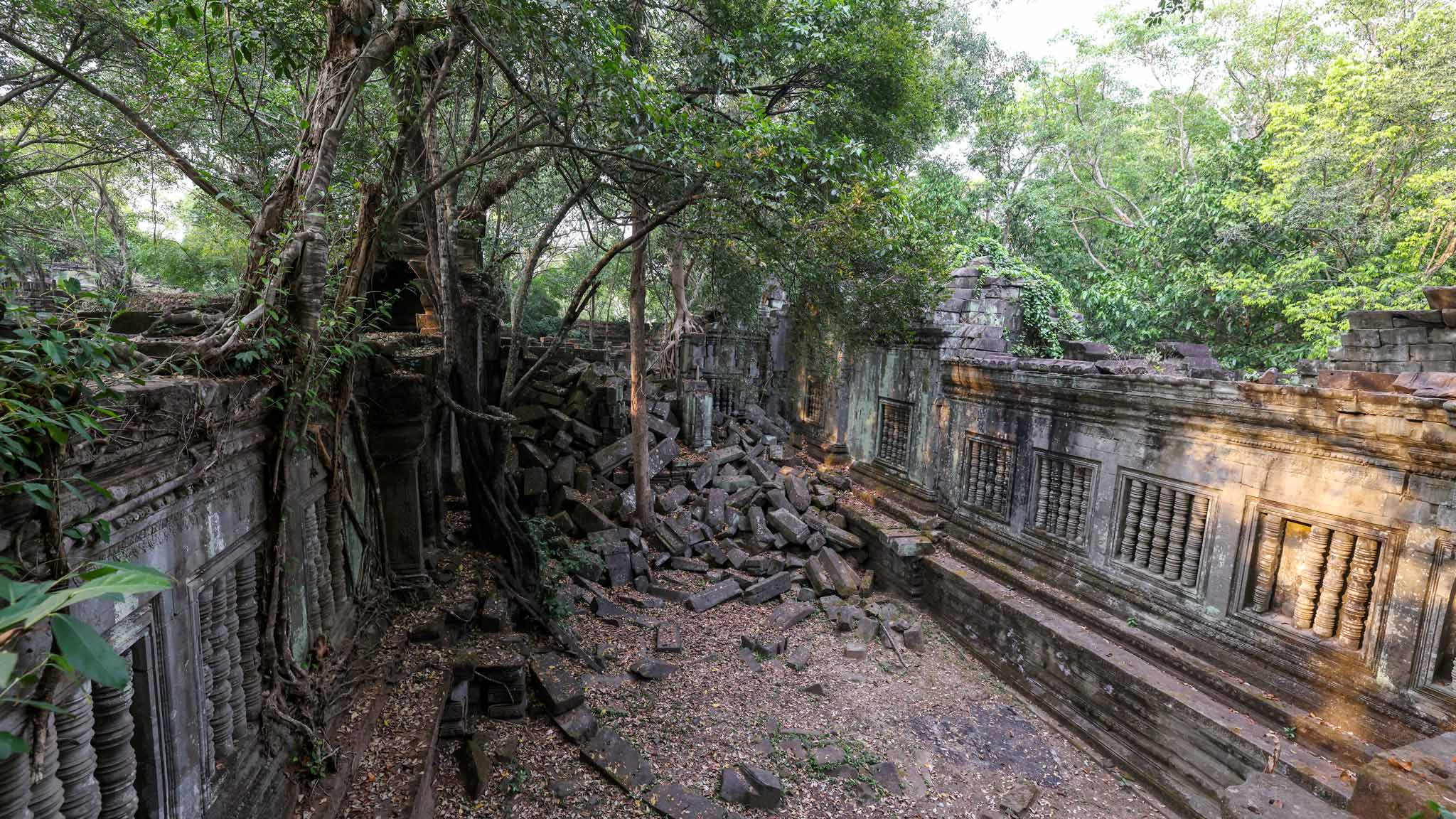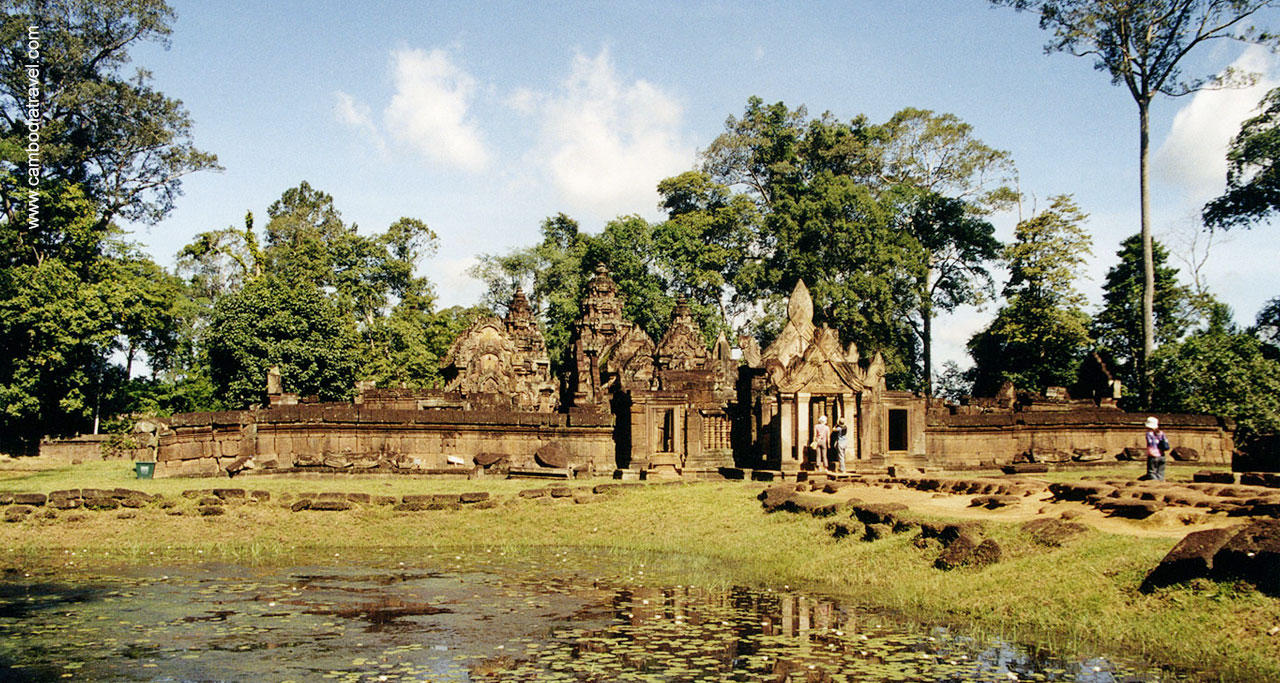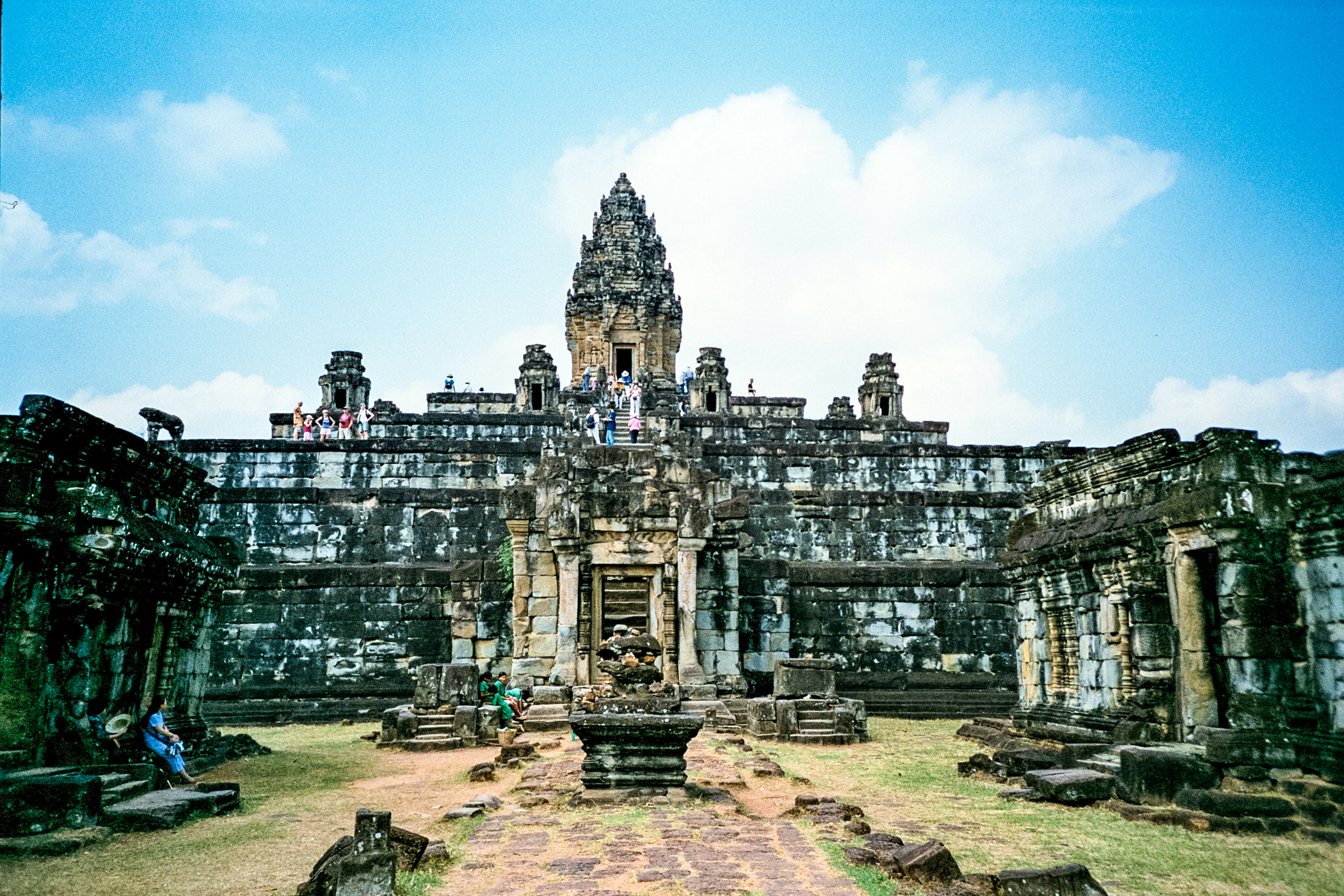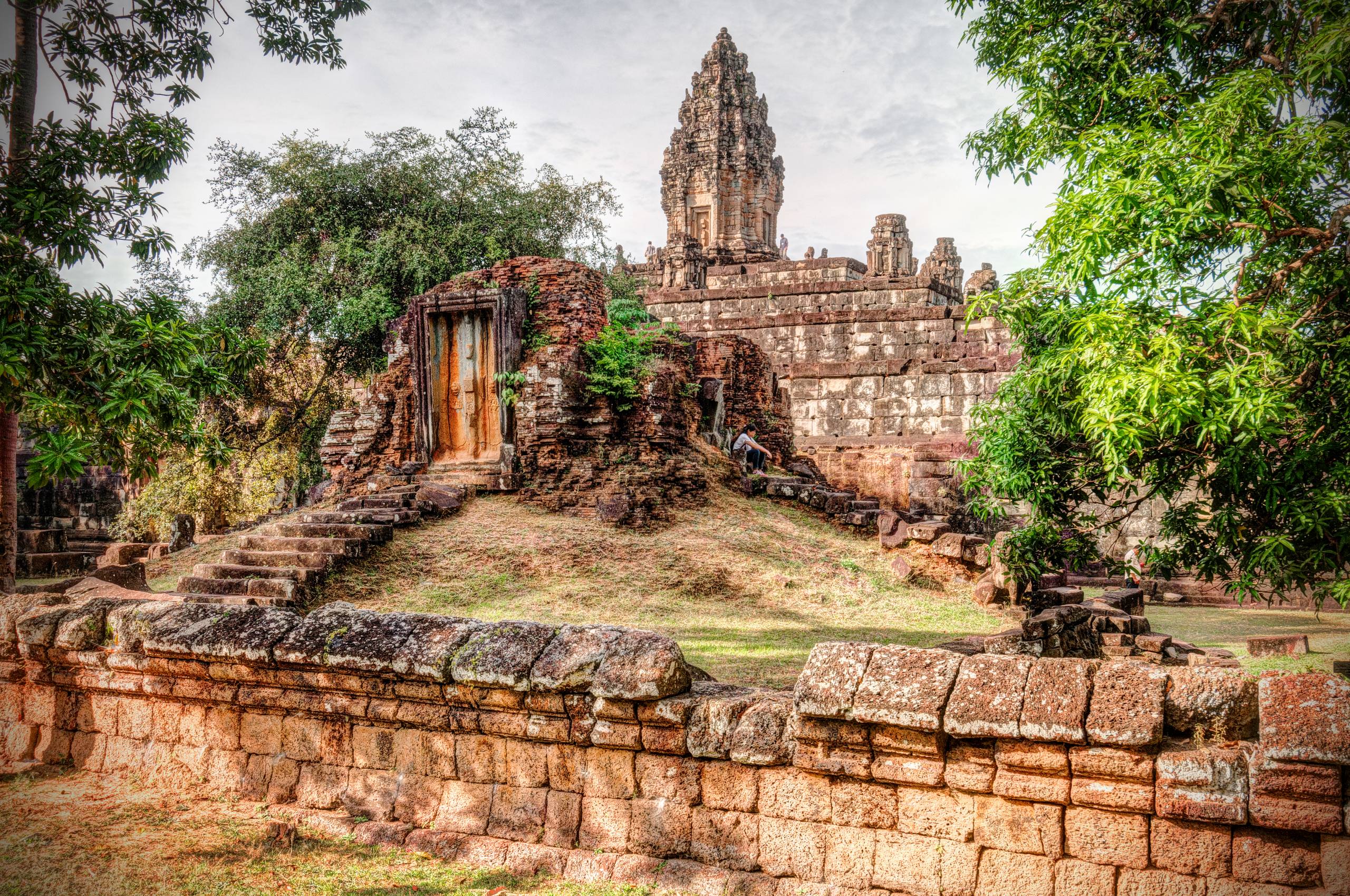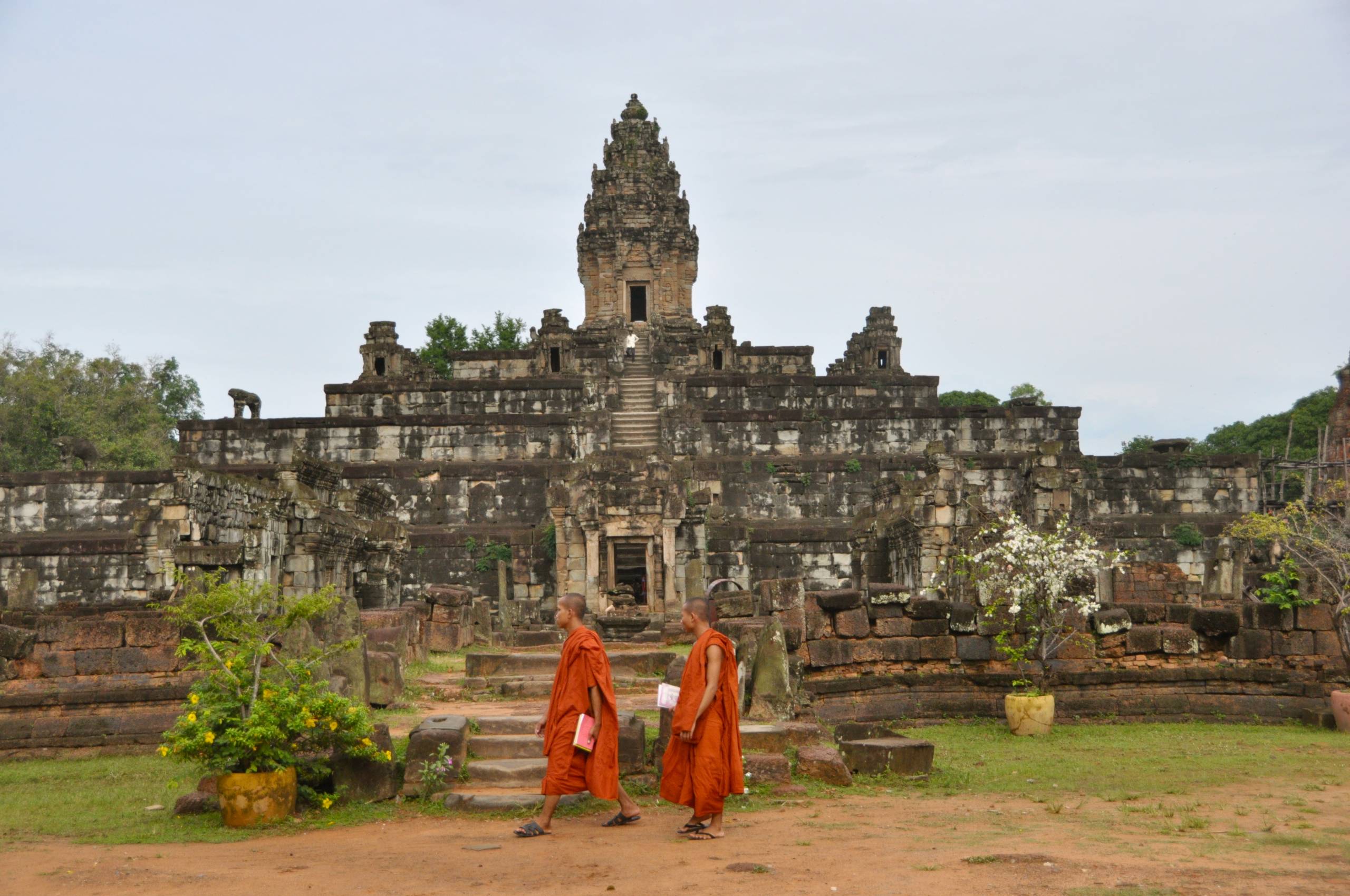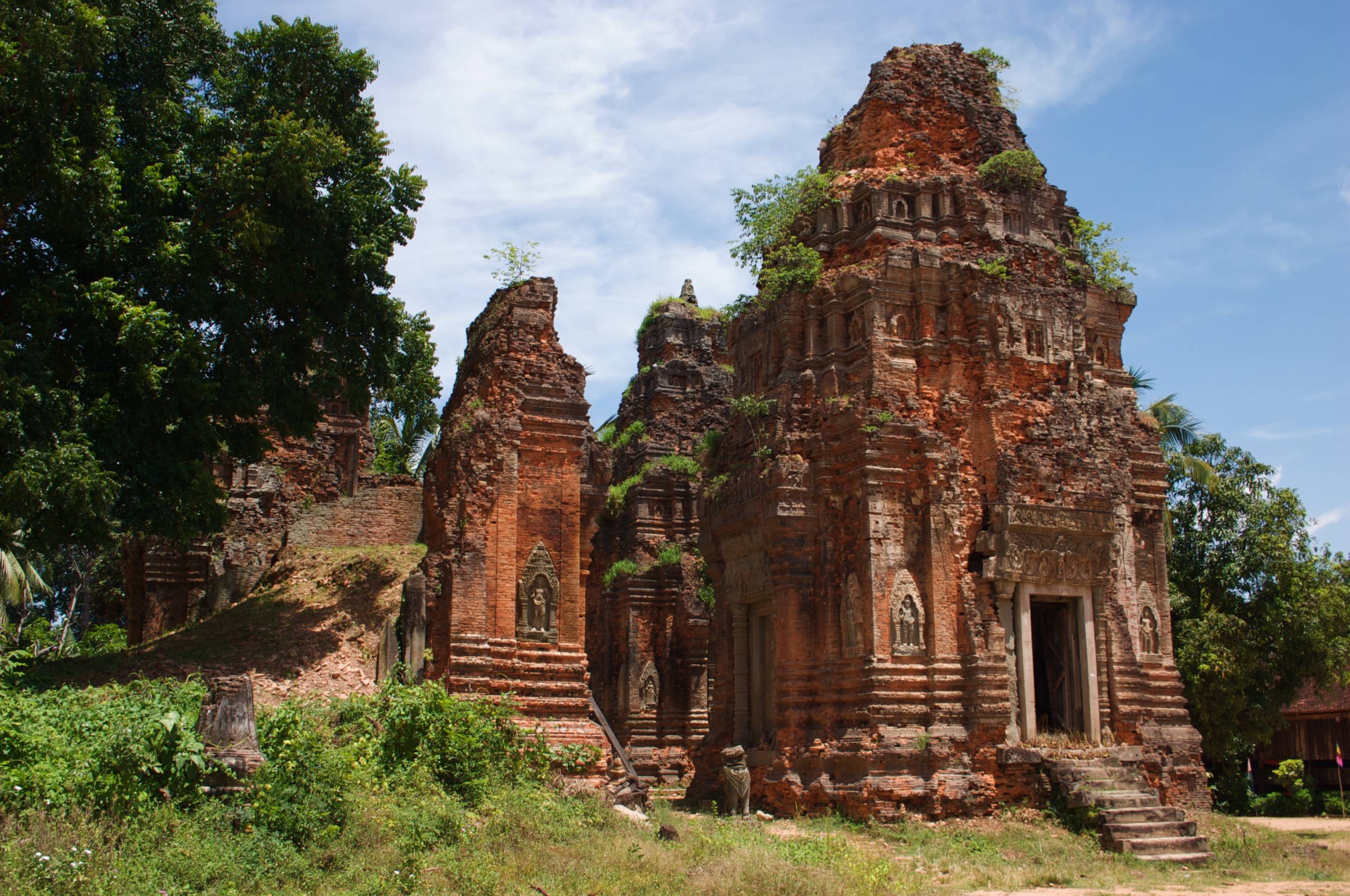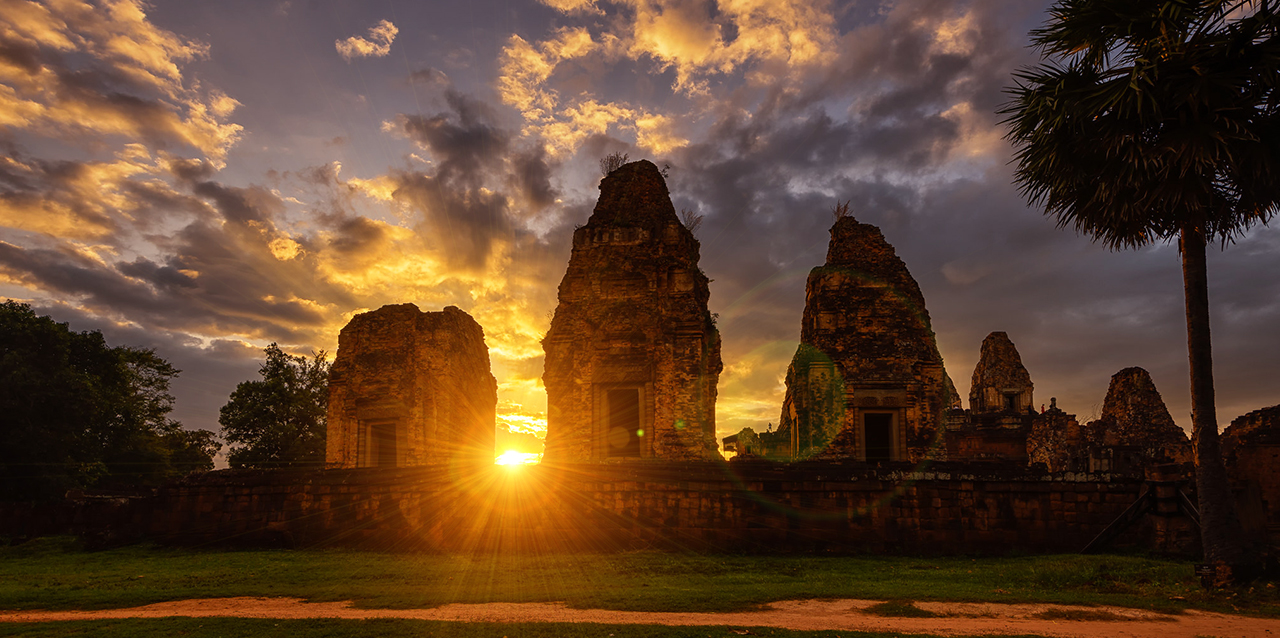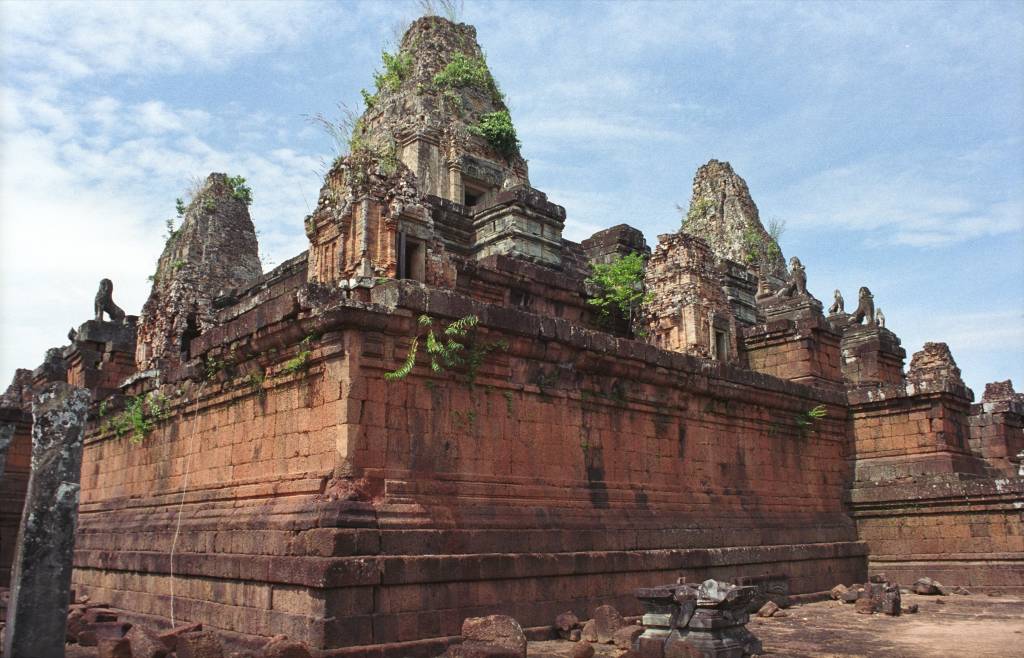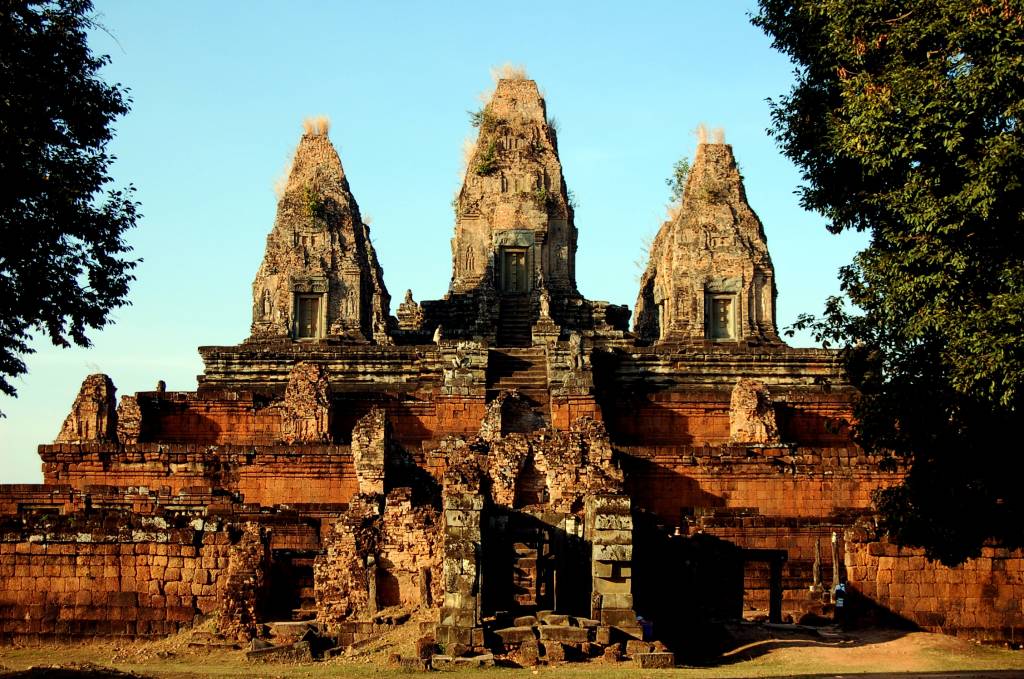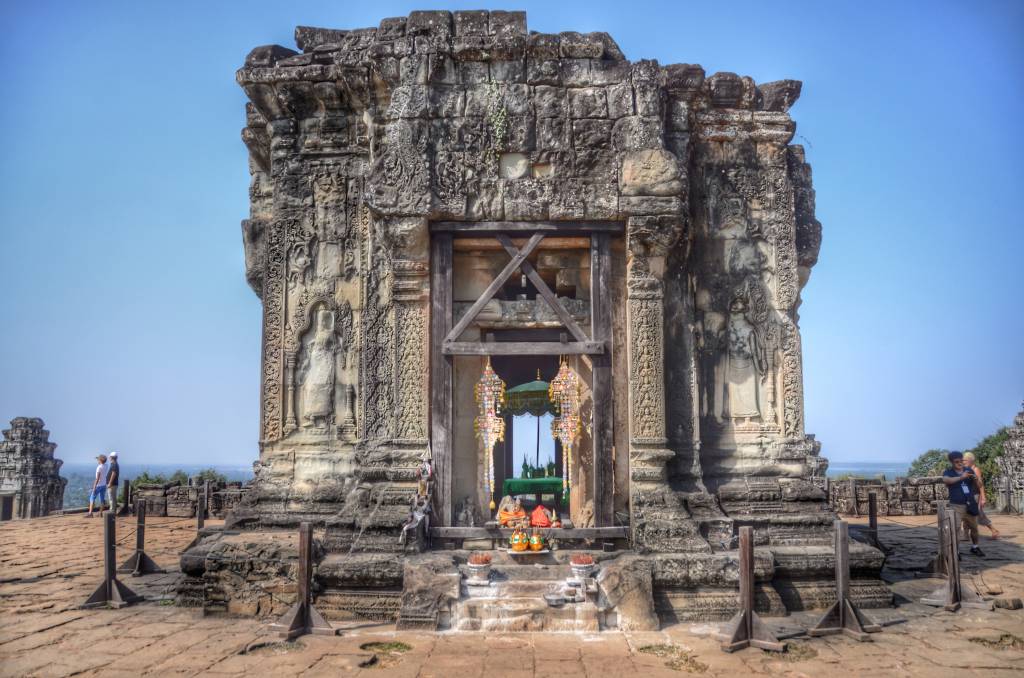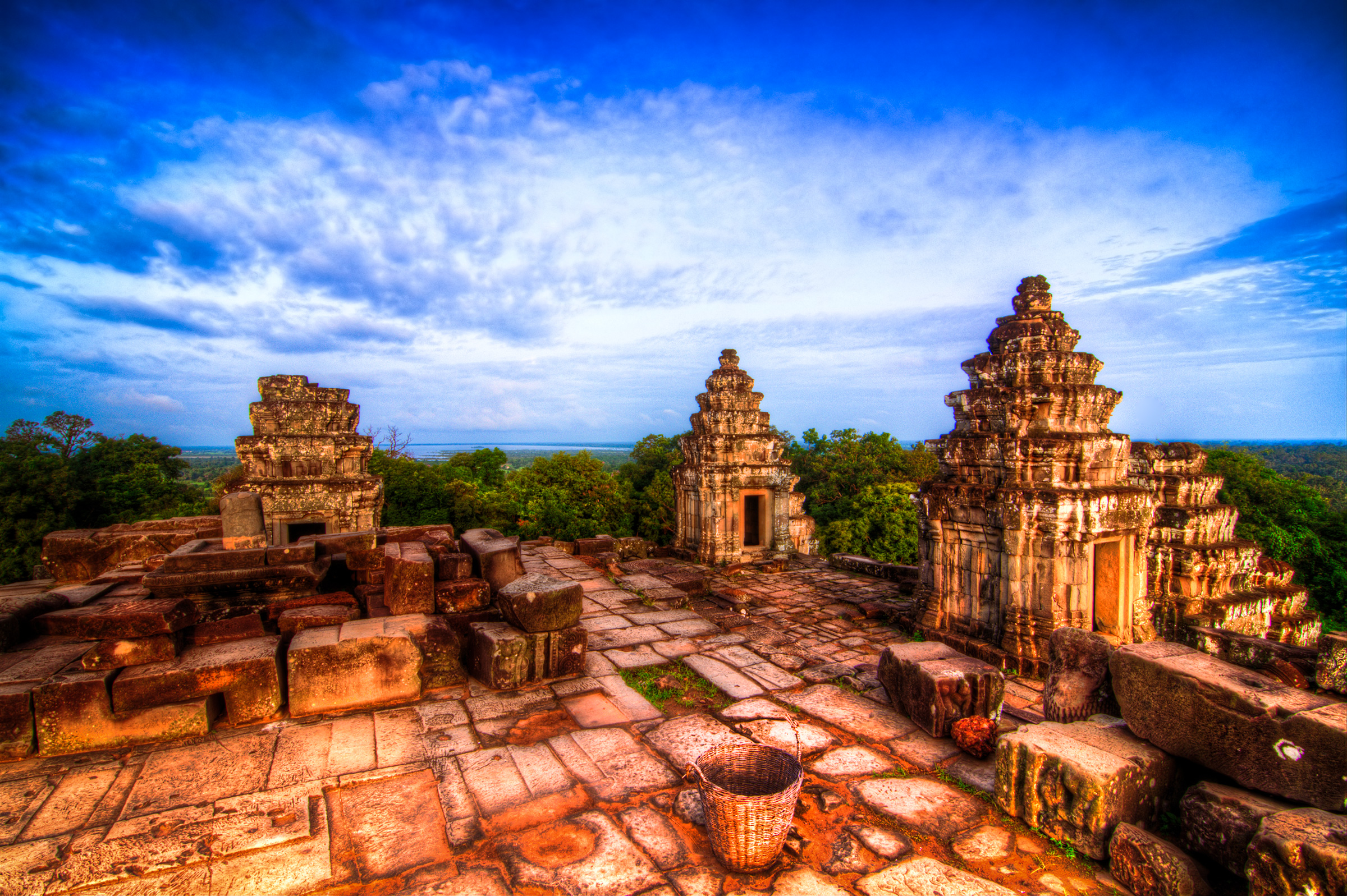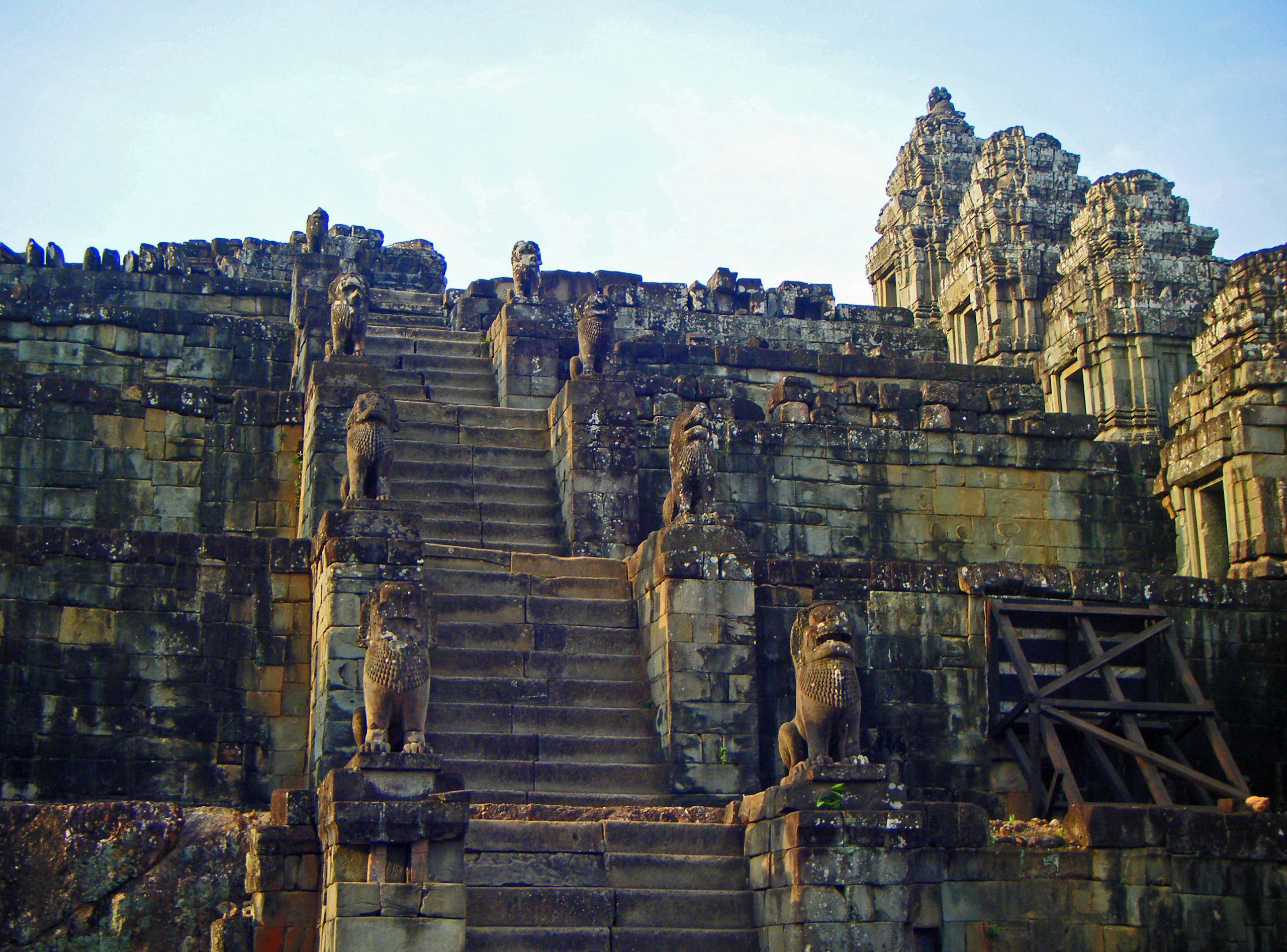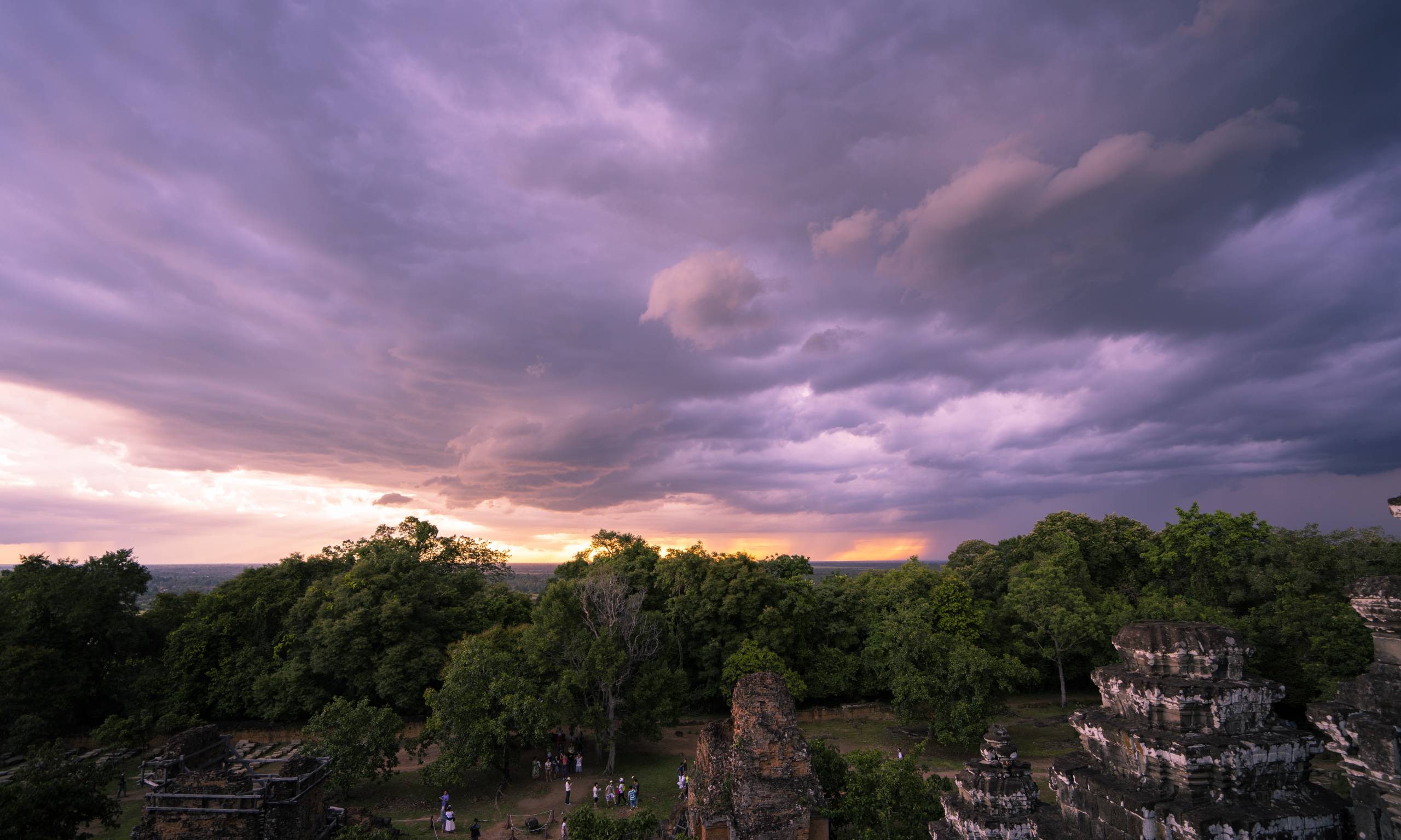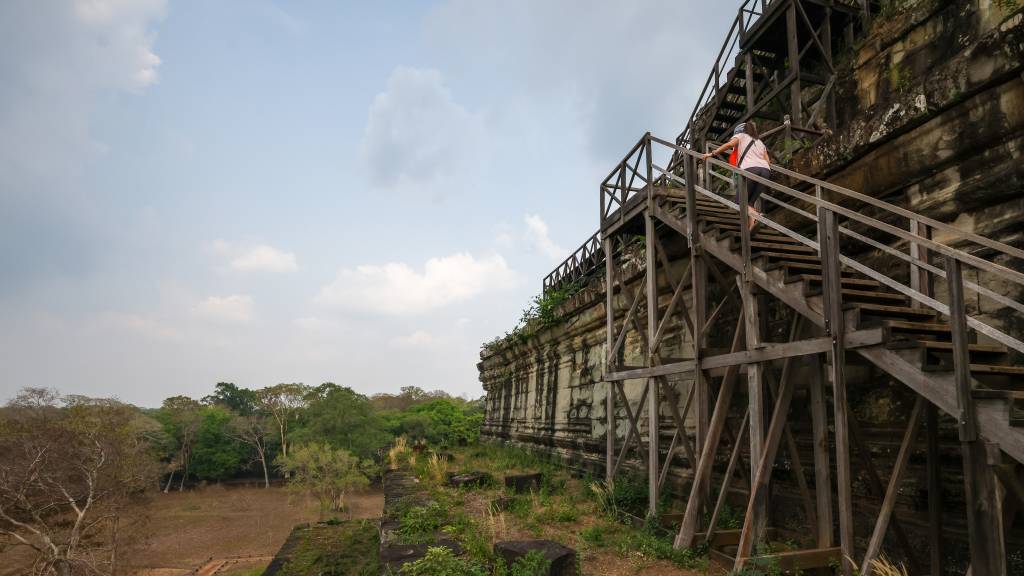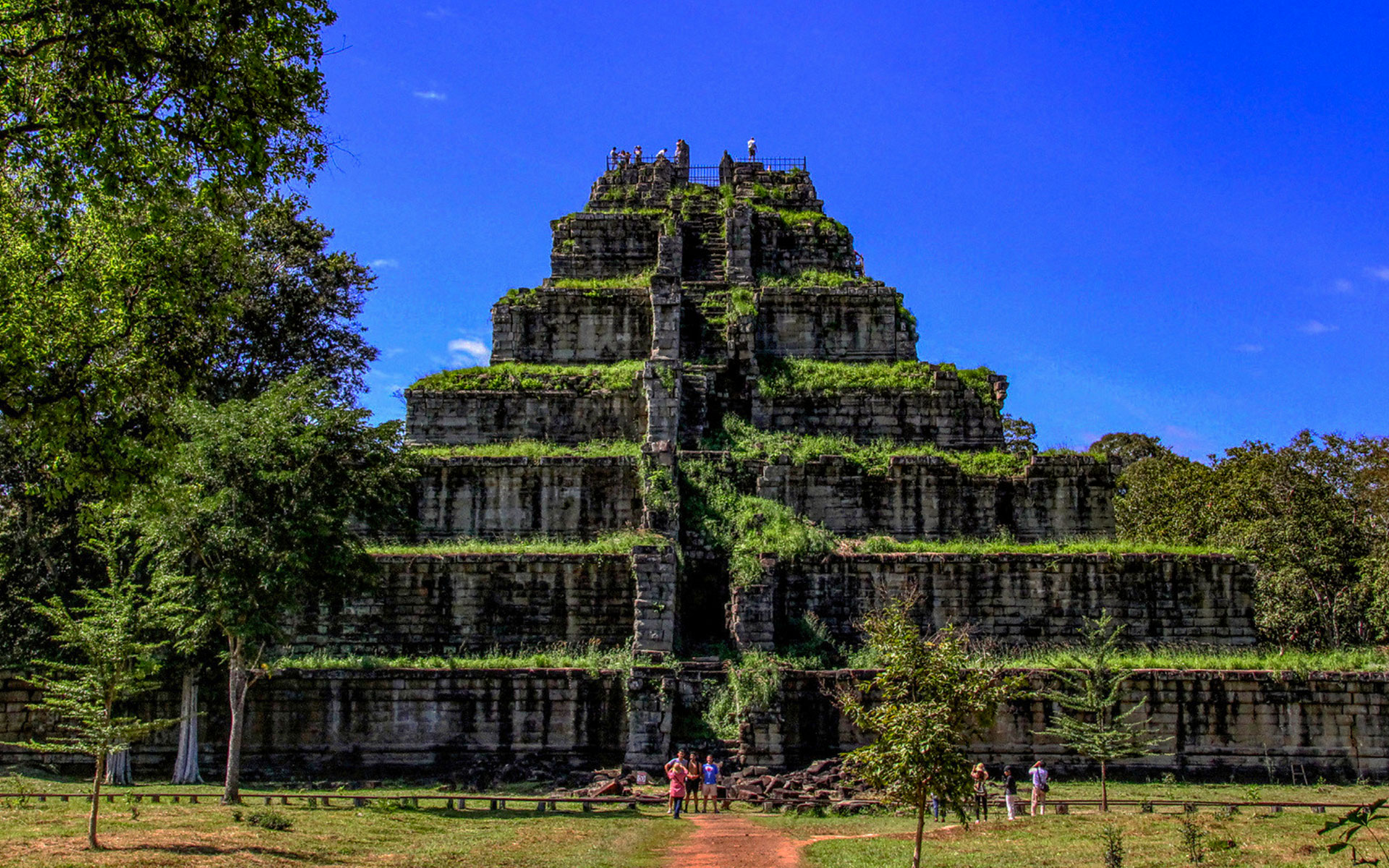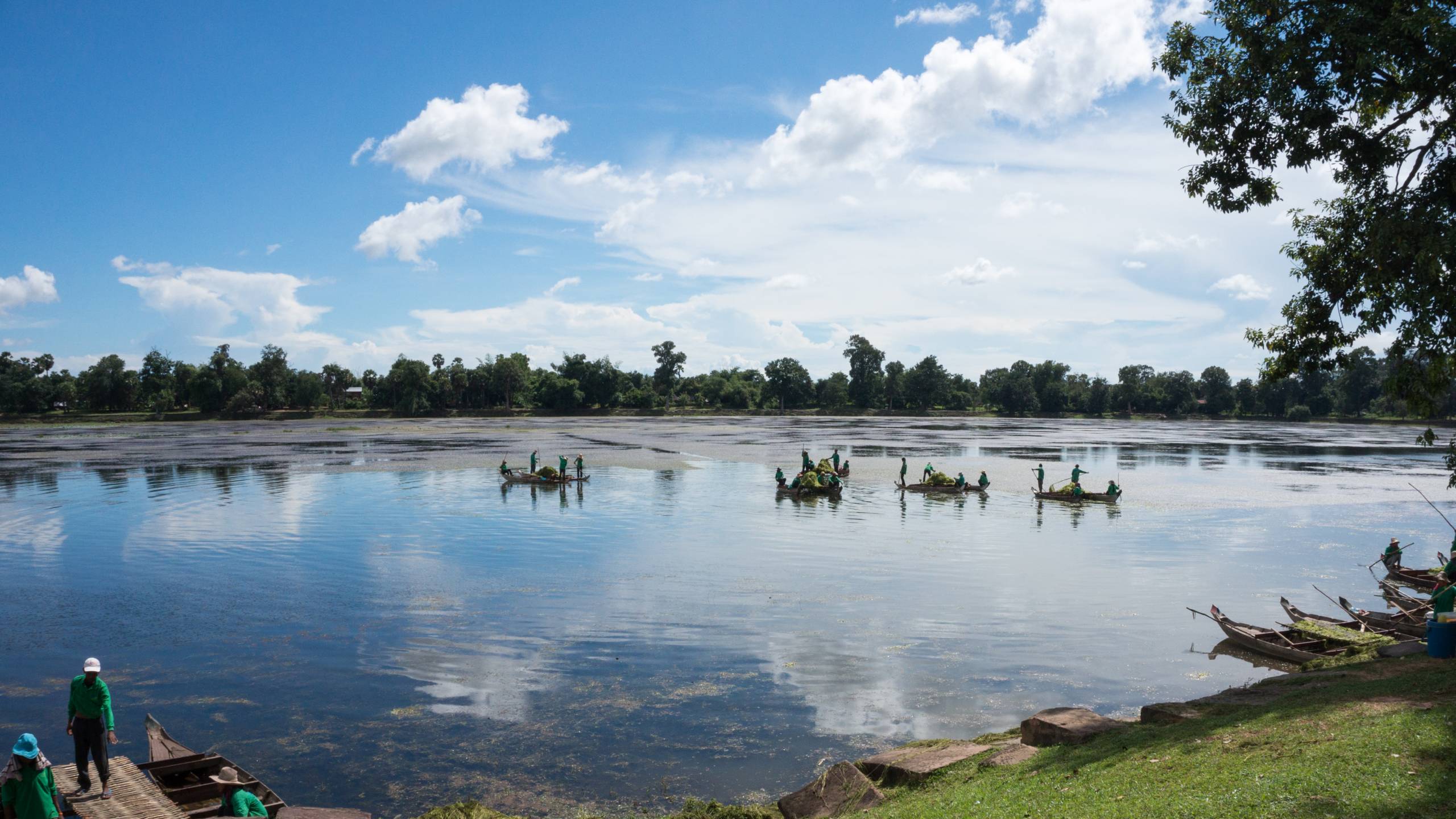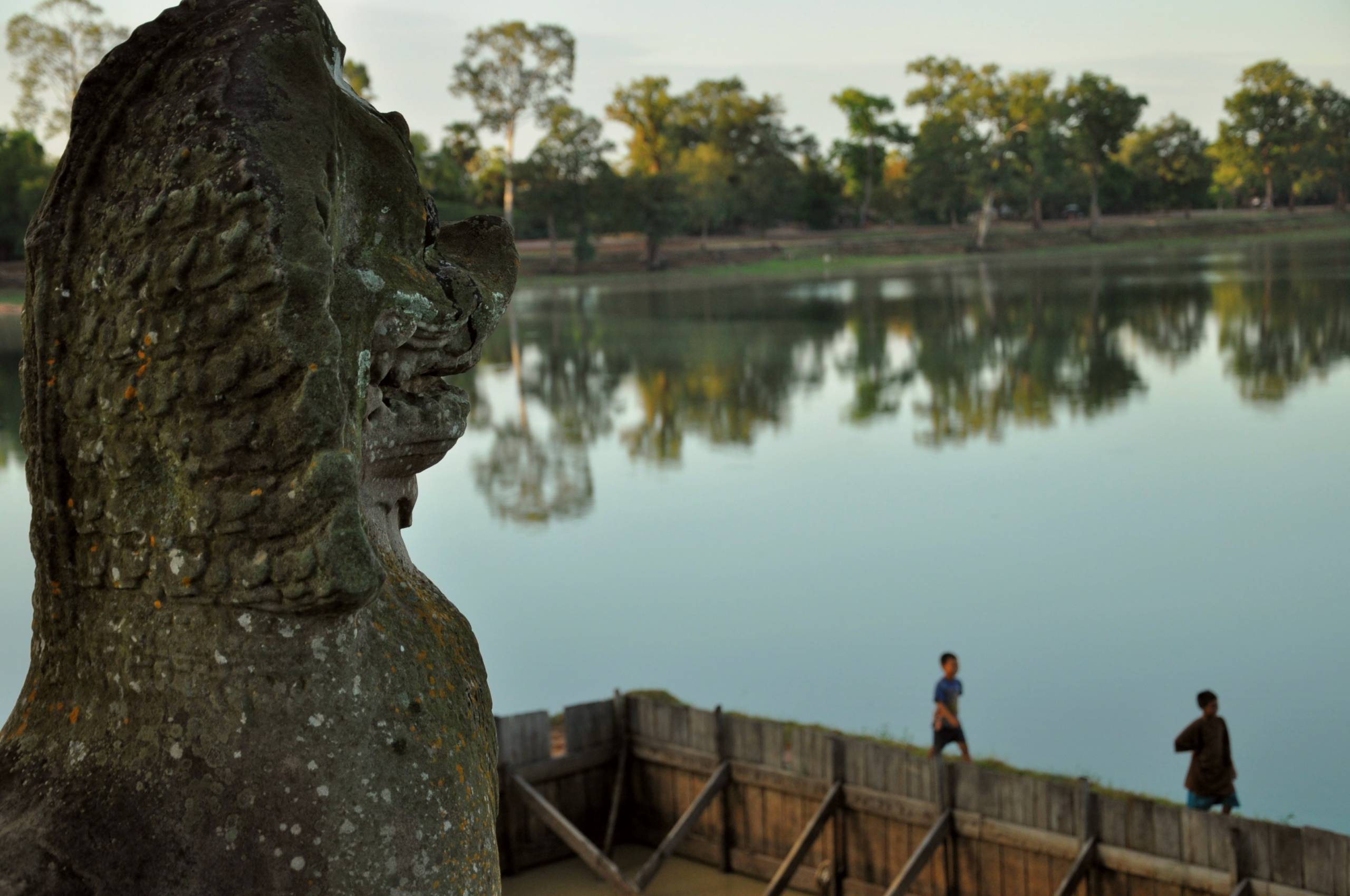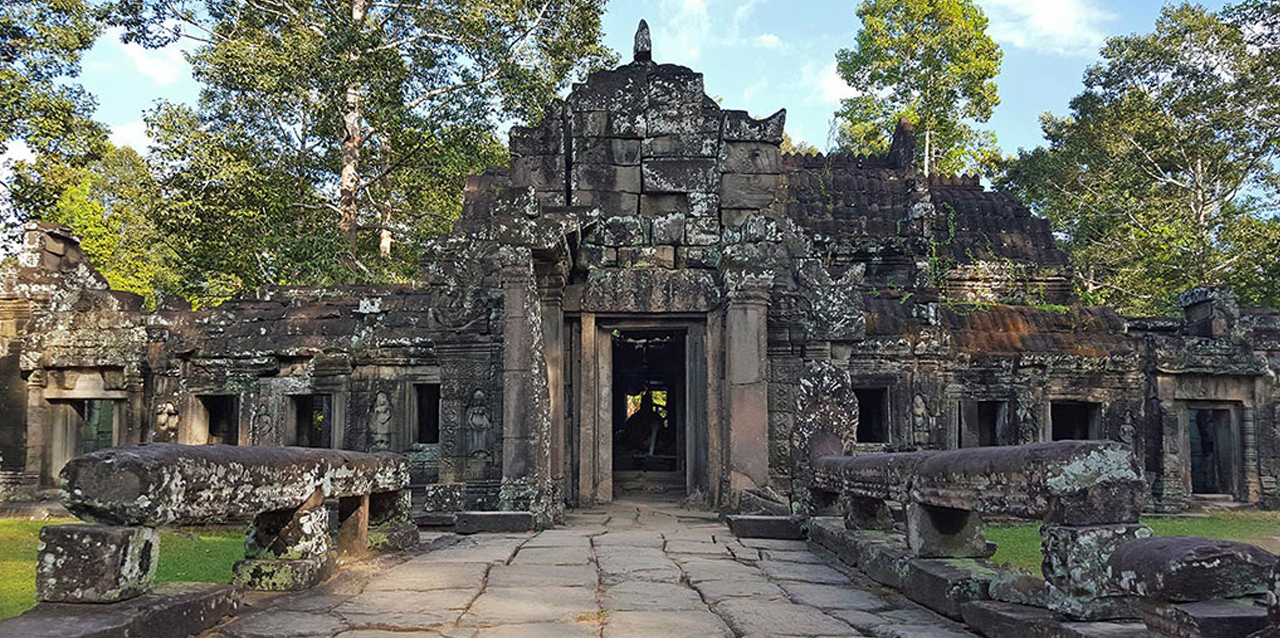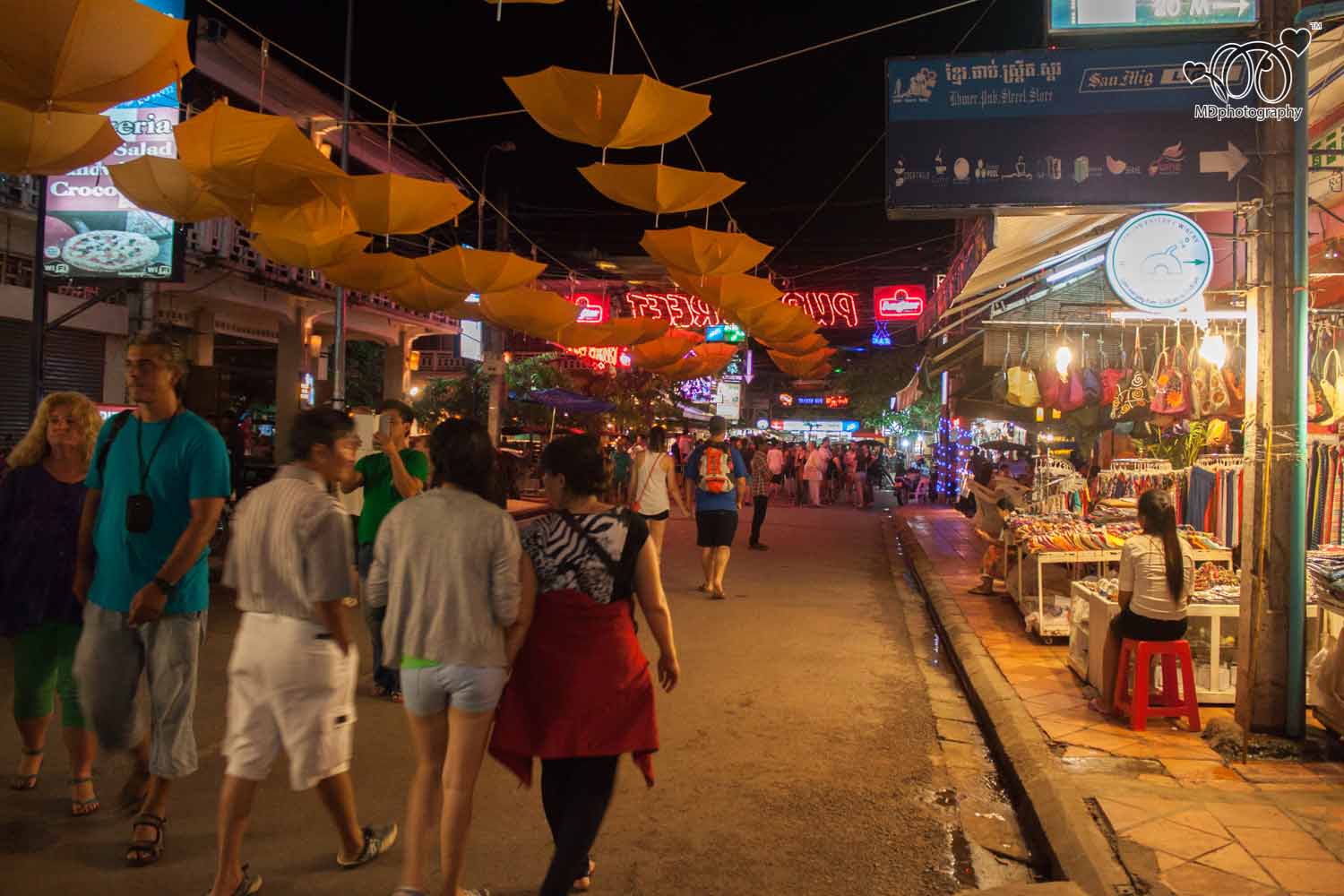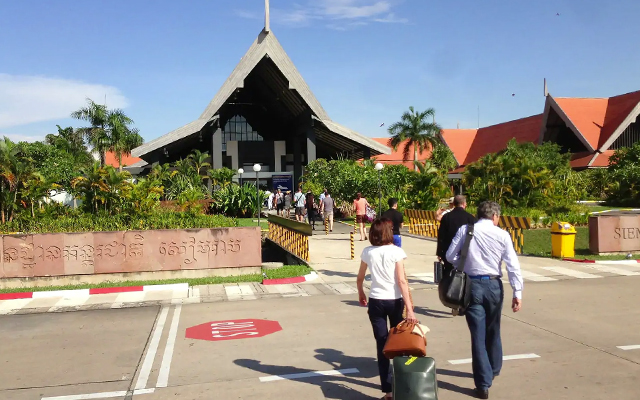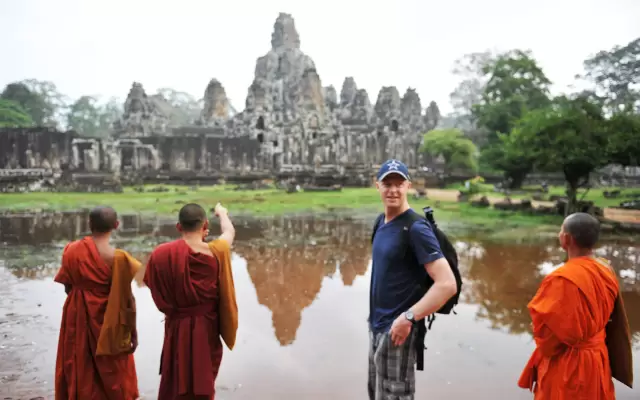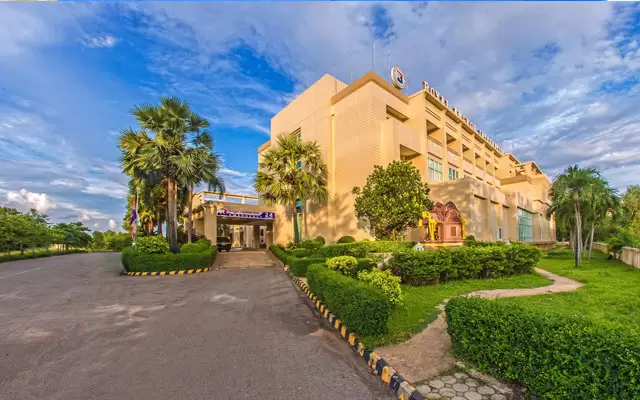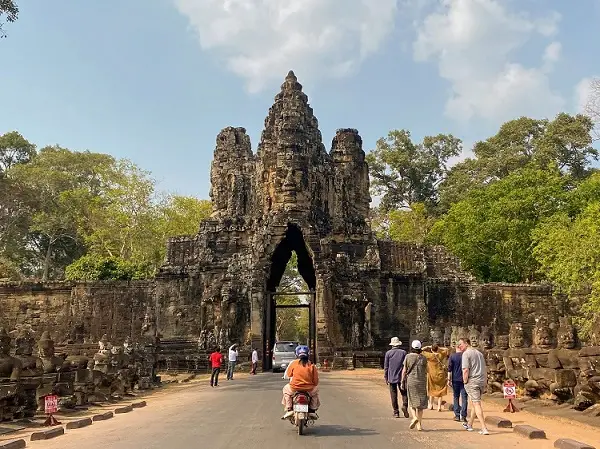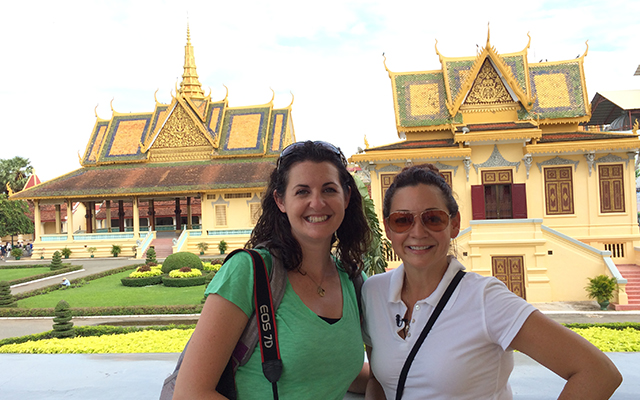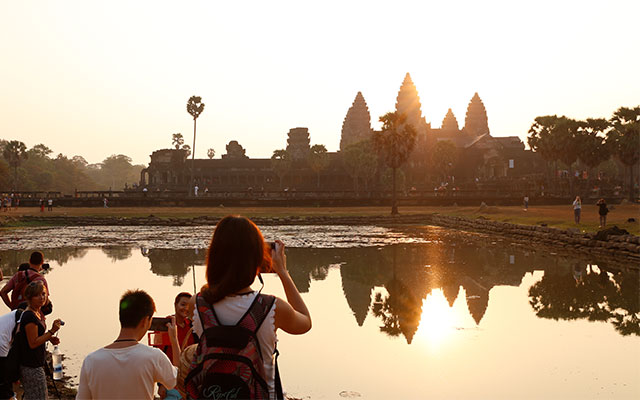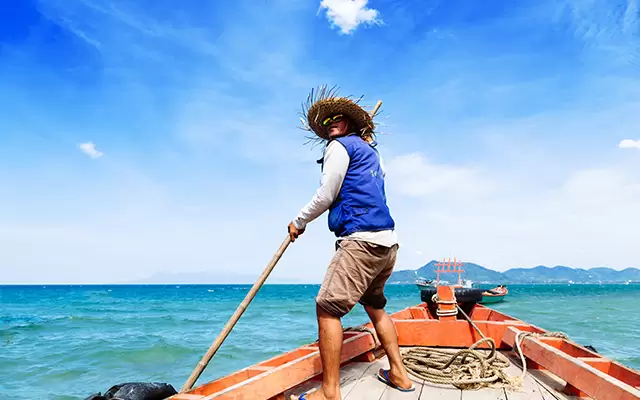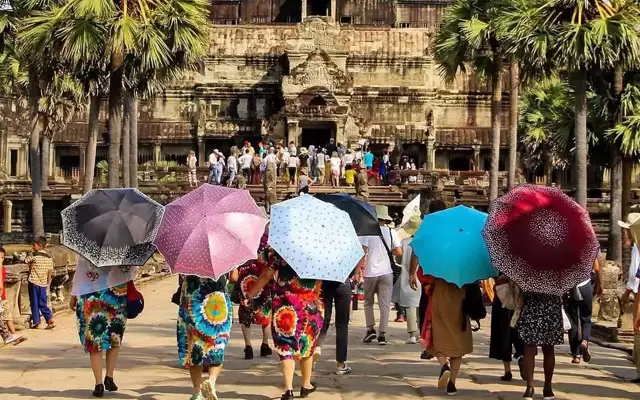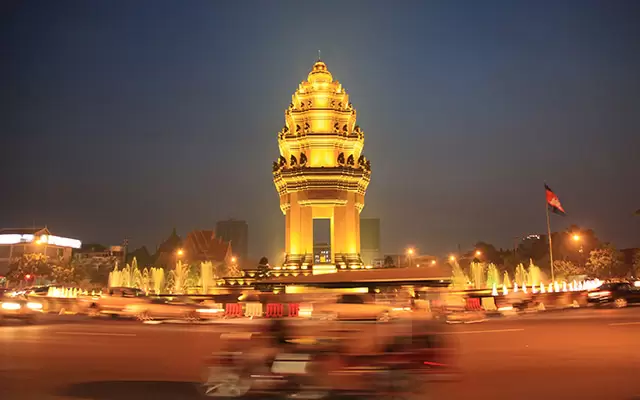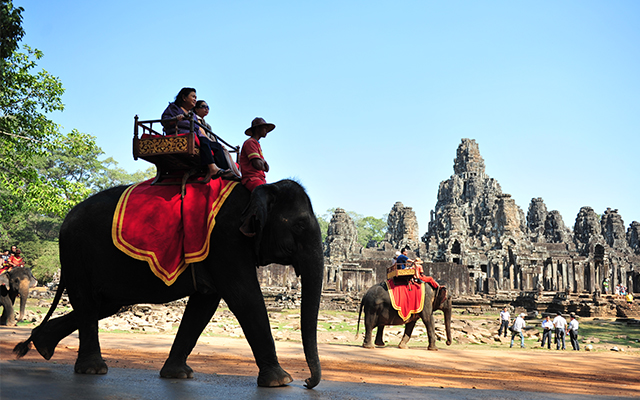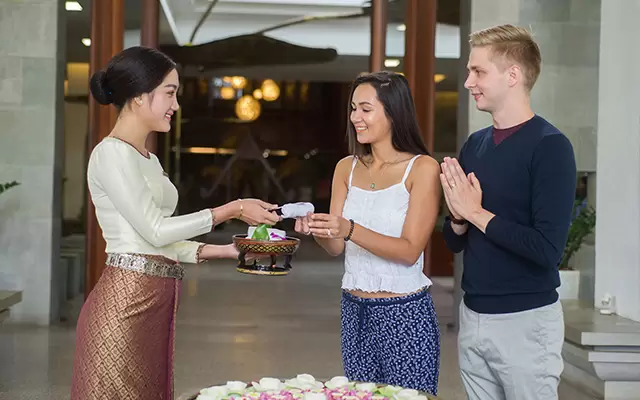Top 15 Tourist Attractions in Siem Reap That You Can’t Miss

Silhouette of Angkor Wat temple against a pink and purple sky during sunrise, the most famous attraction in Siem Reap.
Siem Reap, Cambodia is a unique and captivating tourist destination, with a rich history, awe-inspiring architecture, and a variety of cosmopolitan activities to enjoy. As the second-largest city in the country and home to some of its most popular tourist attractions, Siem Reap offers a diverse range of experiences, from fascinating museums and breathtaking temples to bustling street markets filled with delicious food and unique souvenirs. But it also offers something unexpected, such as intricate dioramas, cutting-edge art galleries, and cultural performances.
Whether you want to delve into ancient civilizations, try local cuisine, or create something of your own, this city has something for everyone. Get ready for some of the top attractions in Siem Reap that every visitor should consider adding to their itinerary.
Table of Contents
Must-Visit Places in Siem Reap:
Siem Reap, nestled in the heart of Cambodia, is a captivating city that promises an unforgettable journey through time and culture. From awe-inspiring temples to vibrant markets, from serene landscapes to exhilarating experiences, Siem Reap offers a unique blend of ancient wonders, cultural experiences, and stunning natural beauty. From exploring the majestic temples of Angkor to cruising on the Tonlé Sap Lake, here are some of the top places you shouldn’t miss in Siem Reap:
Angkor Wat
Angkor Wat, the world’s largest religious monument, draws numerous tourists to Cambodia. Situated in the Angkor Archaeological Park, it stands as one of Asia’s most significant and visually stunning attractions in Siem Reap, surrounded by lush forests and impressive temples.
The brilliance of Khmer art and engineering is showcased in Angkor Wat, a testament to Suryavarman II’s rule from 1113 to around 1150 AD. Besides Angkor Wat, Suryavarman II is credited with constructing Beng Melea and Banteay Samre temples. Devoted to Vishnu, the west-oriented Angkor Wat is often considered a funerary temple.
Following Suryavarman II’s death, Angkor Wat was abandoned when Jayavarman established a new capital at Angkor Thom. Yet, the area continued to host a small population until recent times, with the moat providing protection against the encroaching jungle. Unlike Ta Prohm, the temple’s walls sheltered monks during the civil war, making it a unique attraction in Siem Reap.
Angkor Wat was “discovered” by António da Madalena in 1586, but global awareness of the temple was mainly due to the travel writings of French explorer Henri Mouhot in the mid-19th century. The temple was listed as a World Heritage Site in 1992, and restoration work has been ongoing since then.
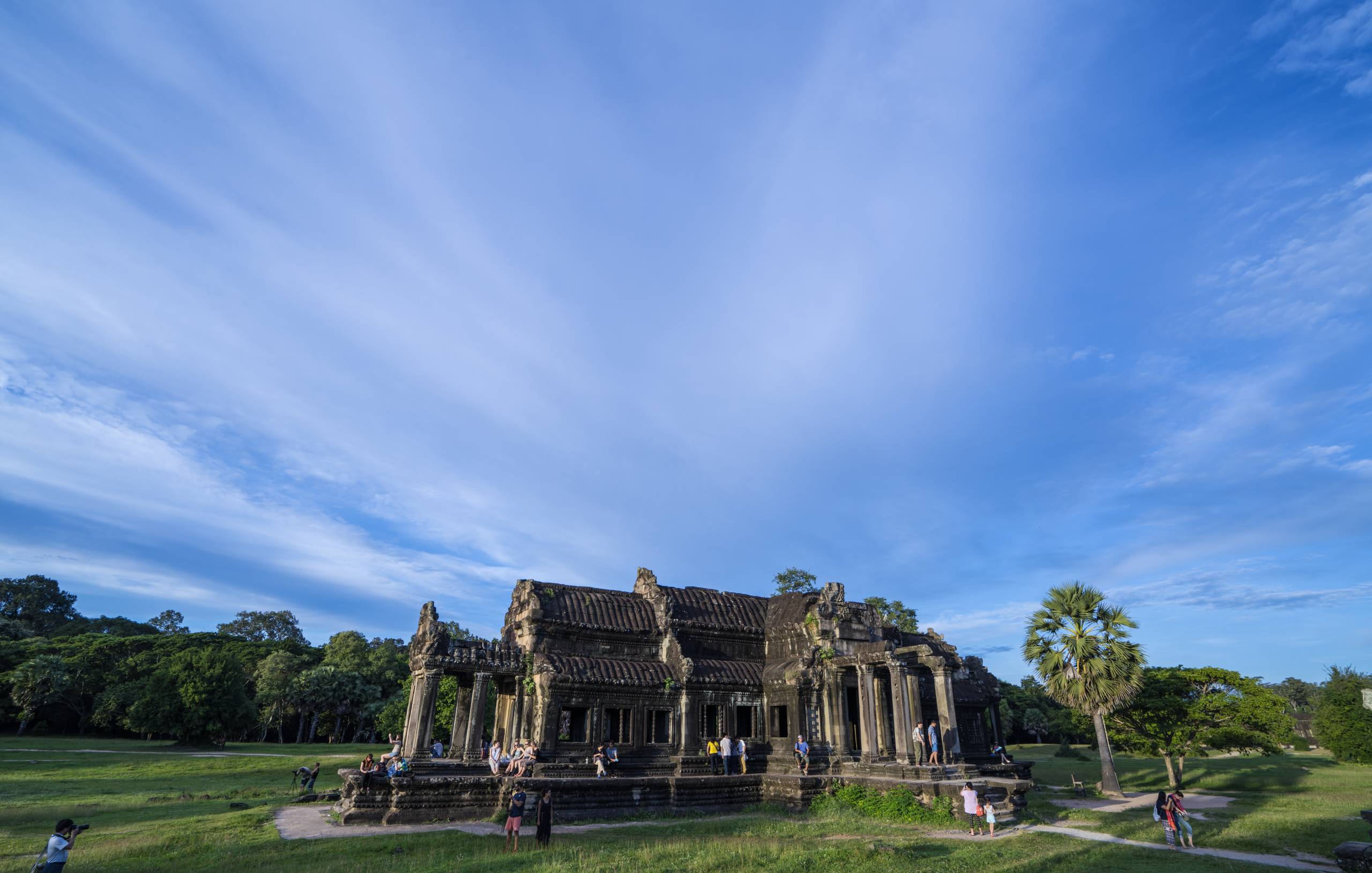
Discover the grandeur of Angkor Wat temple, one of the most iconic and awe-inspiring monuments in the world
Architectural design
The western causeway is the usual entrance for most visitors to Angkor Wat. It is a grand terrace that spans the 200m wide moat and leads to the main entrance. Upon reaching the outer wall, which measures at 1025m by 800m, visitors will find another causeway, two libraries, and the remnants of two pools. Beyond the pools lies the central temple structure, which is designed with three levels.
Each level features a square enclosed by interconnected galleries. The third level, which stands at a height of 42m, was accessible only to the King and the high priest during the temple’s construction. It offers a magnificent view of the Angkor Park and is a remarkable architectural feat. Although the ascent up the third level is steep, the view from the top is worth the effort.
Bas reliefs
Many tourists are drawn to Angkor Wat due to its collection of intricate bas-reliefs that decorate its walls. These carvings, which include depictions of apsaras and devatas, are well-preserved and captivating to behold. Of particular interest are the expansive reliefs that tell detailed stories. Among the most renowned are the Battle of Kurukshetra, the Churning of the Ocean of Milk, and the Army of Suryavarman II.
Tips for visit
– For those planning to catch the sunrise at Angkor Wat, it is important to be patient. Some visitors may become disappointed and leave early as the sky begins to lighten, assuming that there will be no full sunrise. However, if they stay a little longer, they will witness the beautiful lazy orange sun rising over the moat and casting its light across the temple’s towers. It’s a sight not to be missed and worth the wait.
– It is advisable to dress appropriately when visiting Angkor Wat. Clothing that is light and loose-fitting, and covers the shoulders and knees, is recommended. Visitors who do not adhere to the dress code will not be permitted to enter the central sanctuary. It is also important to note that showing too much skin is generally viewed as disrespectful by the majority of Cambodians at religious sites.
– For those seeking a serene escape from the bustling crowds, the East gate of Angkor Wat is a great spot to enjoy the temple’s magnificence in peace. This area boasts a grassy expanse, offering visitors a relaxing place to sit in the shade and soak in the tranquil ambiance.
– If you want to avoid long queues and have a more peaceful experience, it’s best to visit Angkor Wat’s central sanctuary during the typical lunchtime period of 11:30 am to 2 pm. Many people leave the area during this time to grab lunch, giving you the opportunity to explore the temple without as many crowds.
– If you are hesitant about visiting Cambodia during the rainy season, there are actually some advantages to it. The rain fills up the moat and pools at Angkor Wat, creating a stunning landscape. To enjoy this sight without getting wet, make sure to bring a rain poncho and head out early in the day.
Bayon Temple
Centuries before people discovered a temple, it already showcased numerous serene faces with mysterious smiles. This temple, known as Bayon, is situated at the heart of Angkor Thom, the symbolic center of the Khmer Empire and one of the captivating attractions in Siem Reap. Originally called “Jayagiri” or “Victory Mountain,” it was King Jayavarman VII’s dedication to Buddha.
However, during the period of French occupancy, the temple was renamed “Banyan Temple,” reflecting the belief that Buddha attained enlightenment under a banyan tree. This name resonated well with the presence of many banyan trees around the site, adding to its religious significance and the allure of Siem Reap’s cultural attractions.
Notably, the temple’s restoration workers, perhaps inspired by the surroundings, gave it the final name “Bayon,” unintentionally mispronouncing “Banyan.” Thus, Bayon’s name became permanently etched in history as one of the captivating and culturally rich attractions in Siem Reap, known for its serene faces and mysterious smiles.
The Reason to Visit and when?
The serene stone faces of Bayon are some of the most iconic images from the Angkor Archaeological Park, and missing the chance to witness them firsthand would be a great shame. As one of the “big three” sites to see at Angkor, alongside Angkor Wat and Ta Prohm, Bayon is a must-visit destination for any visitor.
Aside from the numerous giant stone faces with their enigmatic smiles, the site also boasts an impressive collection of well-preserved bas-relief carvings that depict a unique combination of history, mythology, and everyday life scenes. Although Bayon is relatively compact compared to other temples, it is recommended to set aside at least two hours to explore its intricate labyrinth of chambers, passages, and occasionally steep stairways.
The temple offers ample shade, making it a comfortable destination to visit at any time of the day. However, for those looking to avoid crowds, it’s best to visit in the afternoon. With every turn, there are unique photo opportunities, and a knowledgeable guide can assist visitors in capturing the best shots, including the popular composition of visitors standing “nose to nose” with one of the giant heads.
The play of light changes dramatically throughout the day due to the complex structure of the temple and the shade from the surrounding trees. In the hours just after sunrise and just before sunset, there is minimal direct sunlight, creating an altogether different and equally stunning experience.
Bayon Location and how to get there
Bayon is situated in the very heart of the Angkor Thom complex, located exactly 1.5km from both the North and South gates. It can be accessed from any entry point since it has no moats or surrounding walls, unlike many other Angkor temples.
Rather, Bayon is shielded on all sides by the city of Angkor Thom. As part of the Small Circuit, visitors can effortlessly reach Bayon from any direction, as it is encircled by a road. To arrange a safe and reliable tuk-tuk or taxi driver to guide you through the park, please contact us.
Unique architecture: Bayon has a unique architectural style that distinguishes it from other temples in the Angkor complex, such as Angkor Wat. Over the course of its history, Bayon has undergone several modifications and additions.
Despite its rich history, Bayon does not look particularly impressive from afar, unlike the grand facade of Angkor Wat. It is only when you enter the temple that you can fully appreciate its beauty. Most Angkor temples are constructed with features facing the four cardinal directions, but Bayon’s face towers seem to point in various directions. Although most of the towers have four faces, some have two or three, while the central tower has many more.
The number of face towers is somewhat random, and there is debate about how many towers were part of the temple’s original design. Some believe there were 49, while others suggest 54. One theory is that each tower represented one of the 54 provinces in the Khmer empire at the time of the temple’s construction, symbolically watching over all the kingdom’s inhabitants. However, only 37 of the towers remain standing today due to the passage of time.
Bayon has two richly decorated galleries, serving as enclosures to the temple. The outer gallery depicts scenes from battles, other historical events, and images of everyday life. The inner gallery primarily illustrates mythological tales. The bas-relief carvings are highly detailed, featuring over 11,000 figures.
The inner gallery, added by the Hindu King Jayavarman VIII, is elevated above ground level. The upper terrace, which contains over 200 giant faces, is one level higher, and a circular central tower rises to 43m high.
Ancient history
Bayon, the last state temple constructed within the Angkor complex, was initiated near the end of King Jayavarman VII’s life in the late 12th or early 13th century. Originally designed to be a Mahayana Buddhist temple, it was later altered during the reign of King Jayavarman VIII in the mid-13th century, when the empire temporarily reverted back to Hinduism. In the following years, Bayon underwent further modifications under the Theravada Buddhist kings.
The most remarkable aspect of Bayon is the subject of some debate among scholars. Some suggest that the serene faces adorning the temple are intended to represent Lokesvara, the Bodhisattva of compassion. In fact, these serene faces are commonly referred to as the “200 faces of Lokesvara.” Others argue that the faces are portraits of King Jayavarman VII, as they bear a striking resemblance to other statues of the king. Both theories could potentially be true, as many Khmer rulers viewed themselves as “god-kings.”
Tips for visiting
If you’re planning to visit Bayon Temple, here are some tips that can help make your experience more enjoyable:
- Plan your visit during the early morning or late afternoon: The temple can get very crowded during the day, so try to visit during the early morning or late afternoon when there are fewer visitors.
- Dress appropriately: Bayon Temple is a religious site, so it’s important to dress respectfully. Wear clothing that covers your shoulders and knees, and avoid wearing hats or sunglasses inside the temple.
- Hire a guide: Hiring a guide can be a great way to learn more about the history and significance of Bayon Temple. They can also help you navigate the complex and point out important features that you might otherwise miss.
- Bring water and sunscreen: The temple complex can get very hot, so it’s important to stay hydrated and protect your skin from the sun.
- Be prepared for stairs: Bayon Temple has steep staircases and narrow corridors, so wear comfortable shoes and be prepared to climb.
- Respect the temple: Bayon Temple is a sacred site, so it’s important to be respectful of the environment and the people around you. Avoid touching or climbing on the temple structures, and be mindful of your noise level.
Ta Prohm
The release of the movie Tomb Raider featuring the Ta Prohm temple in 2001 greatly contributed to the popularity of Cambodia as a tourist destination. Fast forward to today, over fifteen years later, Siem Reap attracts millions of visitors annually, with many wanting to take a picture under the same tree where Angelina Jolie was filmed during an action scene in the movie.
Ta Prohm is more than just its famous counterparts, Angkor Wat and Angkor Thom, and should not be overlooked as a must-see temple solely because of its association with the movie industry. The temple’s mesmerizing qualities extend far beyond its Hollywood status.
Interestingly, it is the decision not to remove the trees from the site and preserve some of the most impressive jungle-overrun ruins that drew the attention of film location scouts, making Ta Prohm one of the most atmospheric and frequently photographed temples of all. In fact, it could arguably be considered one of the “big three” temples in its own right.
Location and how to visit
Ta Prohm is located in the small circuit of the Angkor complex, only a few minutes away from Angkor Wat or Angkor Thom by tuk-tuk. The temple’s main buildings are surrounded by a large wall and cannot be immediately seen from the road. Instead, visitors must take a short walk on a jungle-lined path to discover them. A wonderful way to experience Ta Prohm is by biking through the trails in the Angkor forest and taking the lesser-used gates. An experienced bike guide is necessary to navigate the crisscross paths, but it’s a magical way to explore the area and arrive at the inner enclosures of the temple.
Most visitors include Ta Prohm in their one-day pass at the temples, along with Angkor Thom and Angkor Wat. However, Ta Prohm is surrounded by numerous other smaller sites that are worth exploring for a full day of adventure. Banteay Kdei and Ta Nei, in particular, are lesser-visited but fascinating sites that provide a peaceful escape from the crowds.
Entrance Fee
To visit Ta Prohm, visitors can use their temple pass for the Angkor Archaeological Park. There is no separate entrance fee required to enter the temple.
Best time to visit
For the best experience at Ta Prohm temple, it is recommended to visit early in the morning when most visitors are at Angkor Wat. The surrounding jungle comes alive with sounds, and the lighting is ideal for avid photographers who want to capture the ongoing battle between nature and architecture.
History of Ta Prohm temple
Originally named Rajavihara, which means “monastery of the King,” Ta Prohm was constructed as a Mahayana Buddhist monastery and university in 1186 AD. However, it is believed to have been expanded and adorned over several years.
According to Maurice Glaize, who evaluated the temple, many temples in the Bayon style were attributed to a single king, Jayavarman VII, during his twenty-year reign. However, it seems more probable today that he could have only transformed, extended, or completed existing religious sites during his short rule.
Jayavarman VII dedicated Ta Prohm to his family, as evidenced by the inscriptions on the stele. The stele lists many of Jayavarman’s ancestors and details the construction project at the site. However, the most compelling aspect of the inscription is the information it provides about the people who were connected to this location.
Almost 80,000 individuals from over 3,000 surrounding villages were involved in serving the temple, and the stele mentions that there were 102 functional hospitals in the Kingdom. Such figures provide a remarkable insight into the vast size of the Khmer Empire during that period.
Layout of the Temple
Ta Prohm temple was intentionally preserved in a mostly ruined state, earning it the nickname “jungle temple.” Consequently, the site can be challenging to navigate as some areas are inaccessible, and visitors may be tempted to explore based on the impressive tree formations rather than any clear temple plan.
The temple’s layout is relatively straightforward, consisting of several one-story buildings enclosed by a rectangular wall measuring 600 by 1000 meters. This wall would have once surrounded a substantial town, but now the temple is engulfed by jungle. At the east end of the site, four smaller walls wrap around the central sanctuary.
Most visitors enter the temple from the west, crossing a stone terrace in the shape of a cross that spans a narrow moat. This leads to the fourth enclosing wall and the heart of the Ta Prohm experience. The inner sanctum contains courtyards, passageways, and towers all engulfed by nature – partially destroyed and partially preserved by the encroaching jungle.
Some buildings in the inner enclosures, like the libraries in the first and third enclosures, were likely added in later years. The famous Tomb Raider tree, which appears to strangle and support the ruins beneath its roots, is located in the central sanctuary and is a remarkable sight to behold.
Found a dinosaur carving in Ta Prohm
The stegosaurus carving in Ta Prohm is a controversial topic among historians and archaeologists. Some believe that the carving is a modern-day hoax or a result of erosion on the rock, while others argue that it is an actual depiction of a stegosaurus and that it proves the existence of dinosaurs in Cambodia during the time of the Khmer empire.
There are several other theories about the carving as well, including that it is a representation of a mythical creature or a different type of animal altogether. Regardless of its true meaning, the stegosaurus carving has become a popular attraction at Ta Prohm and adds to the mystical and enigmatic atmosphere of the temple.
Banteay Srei
Banteay Srei, a small but unique temple that stands out from the grandeur of the main Angkorian complex, is often referred to by different nicknames such as “the lady temple,” “the tiny temple,” and “the pink temple,” making it one of the captivating attractions in Siem Reap. Originally named Tribhuvanamahesvara, the temple’s modern name, Banteay Srei (or Banteay Srey), means “citadel of the women” or “citadel of beauty.”
Some believe that this name was given due to its small size, the pink limestone used in its construction, and the intricate carvings of many devatas (minor female deities) adorning its walls, adding to the cultural and artistic allure of this Siem Reap attraction.
How to get there
Located approximately 20km from the main Angkor complex and just over 30km from the center of Siem Reap, Banteay Srei can be reached via a pleasant tuk-tuk ride that takes about 30 minutes, passing through charming villages and scenic rice fields. For those feeling more adventurous, biking to the temple is also an option, while taxis provide a more comfortable means of transportation.
En route to the temple, visitors will come across the impressive Landmine Museum, an NGO dedicated to providing relief work for children affected by landmines. This information center is definitely worth a brief visit.
Time to visit
To fully enjoy the beauty of Banteay Srei, it is recommended to visit either in the early morning or late afternoon. The temple lacks significant shade and is quite exposed to the heat during the day, as it does not have the same labyrinth of corridors found in Bayon, nor does it offer shaded areas like Angkor Wat due to its smaller size. Visiting during the cooler hours of the day not only allows for a more comfortable experience, but also provides the chance to capture some stunning photos of the temple’s pink-hued walls in the shifting light.
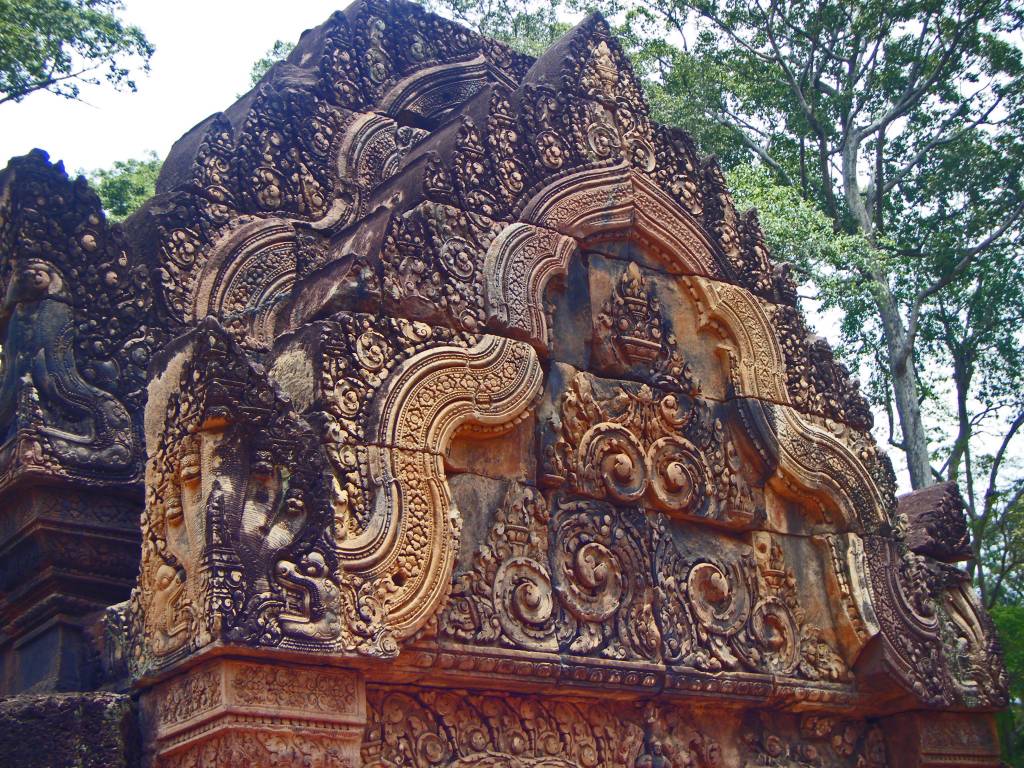
Experience the intricate beauty of Banteay Srei temple, a must-visit destination in Angkor, Cambodia
Banteay Srei Entrance fee
The admission fee for Banteay Srei is already included in the temple pass for the main Angkor complex. It is not possible to purchase a separate ticket solely for this temple, as doing so will require an additional charge of $37. As such, it is advisable to plan a combined visit to Banteay Srei with other nearby sites.
Many visitors opt to spend part of their day at Banteay Srei and then explore other outer temples within the main Angkor complex on their way back to Siem Reap. An often-overlooked temple worth considering is Banteay Samre, situated not far from the road leading to Banteay Srei. This tranquil temple offers a peaceful respite from the crowds and is definitely worth a visit.
Banteay Srei history & rediscovery
Initially thought to have been constructed during the 13th or 14th century due to its exquisite carvings, Banteay Srei’s true age was revealed by inscriptions discovered on site that date its consecration to April 22nd, 967 AD.
Unlike the other major temples of Angkor, Banteay Srei was not built by a King but was instead attributed to Yajnavaraha, a counselor and courtier of the King. The temple underwent expansion and further construction in subsequent years, and remained in use until at least the 14th century.
Banteay Srei was first rediscovered in 1914, but the site was not immediately cleared. A few years later, a French politician and novelist pilfered some artifacts from the site, causing renewed interest in the area and leading to the restoration process.
The temple’s restoration marked the first successful use of anastylosis – a method of restoring ancient architecture using its original elements – which was later employed in the restoration of many other Angkorian structures.
Architecture
Banteay Srei is oriented towards the east, featuring a gate at the entrance of a causeway that leads to three enclosed areas. The causeway has remnants of corridors on either side. The two outer enclosures, which have lost some parts to collapse or been moved to museums, showcase scenes from Hindu mythology. The sandstone used in the temple’s construction has a reddish hue, giving rise to its nickname as the “pink” temple.
The stone is relatively soft, allowing for intricate carvings to be made with ease. As a result, the temple is adorned with ornate decorations and depictions of stories and motifs on virtually every available surface.
The most elaborate carvings can be found in the inner enclosure, which houses two libraries and a sanctuary. The temple is primarily devoted to Shiva, and many of the carvings revolve around this deity, although Vishnu is also prominently featured in the structures on the south side.
Banteay Srei stands out as a unique experience among the other temples of Angkor. Unlike Angkor Wat or Bayon, which impress visitors with their grandeur and weighty sense of history, Banteay Srei instead reveals a display of wealth, power, and religious devotion through intricate and detailed carvings.
The temple’s small size further emphasizes the delicate beauty of its reddish-pink sandstone, which is soft and lends itself to the ornamental decorations that cover nearly every surface. For those who seek a deeper understanding and appreciation of the Kingdom of Angkor, Banteay Srei offers a compelling and contrasting perspective.
Preah Khan temple
Preah Khan temple, constructed in the late 12th century, stands as a prominent Buddhist monastery and educational institution in Siem Reap, attracting both locals and tourists to explore its historical significance. This captivating complex, reminiscent of the nearby Ta Prohm, showcases extensive corridors, halls, and courtyards adorned with galleries and towering pavilions, making it one of the intriguing attractions in Siem Reap.
The temple boasts intricate carvings and bas-reliefs, portraying not only the Hindu god Vishnu and scenes from the Mahabharata and Ramayana but also Buddhist imagery like bodhisattvas and Avalokiteshvara. Home to sacred statues, Preah Khan witnessed the unfortunate looting and destruction of many during the 20th-century wars and conflicts, adding a layer of historical depth to this Siem Reap attraction.
Visitors can leisurely explore the temple complex, immersing themselves in the captivating ruins and the surrounding natural beauty, contributing to the allure of attractions in Siem Reap. Additionally, they have the unique opportunity to witness ongoing restoration efforts led by local and international teams, ensuring the preservation of this significant historical site for generations to come.
Location and How to Get There
Preah Khan is one of the temples included in the Grand Circuit of the Angkor Archaeological Park. This circuit is an extension of the smaller circuit and spans 26 kilometers. To tour this circuit, it’s recommended to hire a tuk-tuk driver. While the smaller circuit is manageable by bicycle, completing the larger circuit in one day can be challenging on a bike.
Located to the north of Angkor Thom, Preah Khan is situated east of the Jayatataka Baray, a man-made body of water that provides stunning reflections of the surrounding jungle and temples. The center of the reservoir contains an island where the Neak Pean temple is located. Although it was previously dried up, the Jayatataka Baray is now full of water again, with all excess water being diverted back into it after the rainy season.
It’s important to note that Preah Khan within the Angkor Archaeological Park should not be confused with the similarly named temple in Kampong Svay, which is situated 100 kilometers east of Angkor.
History of Preah Khan
King Jayavarman VII built Preah Khan in the 12th century to pay homage to his father, King Dharanindravarman II. This temple complex served as a city, a temple, and a Buddhist university, making it a significant and unique structure.
One of the most fascinating features of Preah Khan is the Preah Khan stele, a 2-meter by 0.6-meter carving with inscriptions on all four sides. French conservator of Angkor, Maurice Glaize, discovered it in 1939, and it contains extensive information about the temple’s history.
The stele includes an invocation to Lokeshvara and Prajnaparamita, as well as praise for the three jewels of Buddhism: the Buddha, the Dhamma (Buddhist teachings), and the Sangha (the Buddhist community).
It also provides details about the city within the complex, Nagara Jayasri (the Holy City of Victory), and lists the population of the temple city at 100,000, which included rice farmers, monks, and dancers. The stele also includes information about the treasury of the Kingdom, which held silver, gems, and gold.
Since 1991, Preah Khan has been undergoing restoration and maintenance led by the World Monuments Fund. This project is the first of its kind after Cambodia’s devastating civil war, which occurred between 1967 and 1975.
Architecture
The architecture of Preah Khan is exquisitely embellished, particularly the outer wall adorned with five-meter-tall Garudas engaged in combat with fighting Naga snakes, surrounded by a moat. Access to the temple complex is granted through four gates, each with a causeway over the moat.
The primary entrance is situated on the eastern side, marked by the ruins of a boat landing stage and two lion statues guarding the area. This landing pier is on the western bank of the Jayatataka Baray, where the King would embark on a boat to Neak Pean temple at the center of the reservoir.
A House of Fire is located on the northern side of the complex, resembling those at Ta Prohm and Banteay Chhmar, which historians suggest may have served as rest houses for travelers with fireplaces. The complex consists of four enclosures, with wooden houses of servants and villagers formerly found along the edge of the fourth enclosure.
The third enclosure, beyond the Gopura of the east entrance, houses the impressive Hall of Dancers, similar to those found at Ta Prohm and Banteay Kdei, with meticulously carved Devatas above the entrance doors. The second enclosure, with only a narrow gap between it and the first, contains six sanctuary buildings on the eastern side.
The first enclosure, or inner sanctuary, is the most sacred part of the temple, with Buddha images adorning the walls and small chapels lining the area, including tombs.
Local markets in Siem Reap
If you want to explore unique fruits, fashion, souvenirs, artwork, and other products, you should visit a traditional local market! Siem Reap has several conveniently located markets to choose from. Interact with the locals, immerse yourself in the vibrant atmosphere, and have fun negotiating prices with the vendors. (Pro-tip: You can often bargain down to approximately half of their initial price.) While you’re there, you can indulge in a plethora of colors and flavors from the fruit and vegetable stalls, and savor some of the best street food around.
Phsar Chas (The Old Market)
The Old Market, situated between Pub Street and the riverside, is the beating heart of Siem Reap. As the most prominent and centrally located market, it attracts a lot of visitors, including tourists and locals. It is a popular destination for locals, expats, and businesses to purchase fresh fruits and vegetables. The vendors here generally have a good command of the English language, making it easy to communicate with them.
- Experience: Cooked food, herbs and spices, raw meat, fruit and vegetables, souvenirs, local crafts, DVD’s, clothes, shoes, jewelry, hair and makeup salons, artwork;
- Transfer cost: $1-$2 by tuk tuk, one-way from most central hotels;
- Opening hours: Mon-Sun, 8am-6pm;
Phsar Leu (The Upper Market)
Phsar Leu, also known as Phsar Leu Thom Thmey, is the largest and perhaps the most genuine market in Siem Reap. It is situated on National Road 6, around 3km away from the center en route to Phnom Penh. The market’s outer perimeter is often packed with locals seeking the best deals. It is rare to hear English spoken here, as the market caters mainly to the local population.
- Experience: Raw meat, fruit and vegetables, local snacks, plastic wears, phones and electronics, clothes, shoes, toiletries, beauty and makeup, jewelry.
- Transfer cost: $4-$6 by tuk tuk, return from center;
- Opening hours: Mon-Sun, 6am-6pm;
Tonle Sap Lake
Tonle Sap Lake is often regarded as the soul of Cambodia, as it is a massive freshwater lake that feels almost like an ocean. The Tonle Sap River converges with the Mekong River and Tonle Bassac River at Phnom Penh, and its current changes with the seasons. Cambodia depends on the river’s ebb and flow for crops and fishing at various times of the year. Siem Reap is the nearest significant town for exploring Tonle Sap Lake.
Weather Cycles and Flow Reversal
In April of each year, Khmer New Year is celebrated, marking the end of the harvest season for Cambodian families. This is a time for them to enjoy the fruits of their labor before the rainy season sets in around June.
During this time, the water levels in the Mekong River rise, and the flow from Tonle Sap is reversed. Normally, the water from the Tonle Sap Lake flows along the Tonle Sap River and converges with the Mekong and Tonle Bassac River. However, during the rainy season, the higher water levels push the water back toward the lake, causing the lake to expand through the surrounding wetlands. Tonle Sap becomes the largest freshwater lake in Southeast Asia, swelling in size by up to five times.
When November arrives and the dry season begins, the Tonle Sap Lake is full, and everything is flourishing. The water levels in the Mekong drop, and the river flow goes back the other way. The Water Festival, also known as Bom Om Touk, symbolizes the end of the rainy season.
Rice farmers have been working hard during the rainy season to cultivate one or two crops of rice, and the Water Festival indicates that the rice harvest is coming. There are ceremonies for pounding the rice, known as Ombok, and it is tradition to eat the pounded rice at this time of the year.
Tonle Sap Biosphere Reserve
The Tonle Sap Lake boasts a magnificent and unique biodiversity, surrounded by mangroves, tropical forests, marshlands, and grasslands that serve as habitats for a diverse range of animal species. The western end of the lake houses the Prek Toal Bird Sanctuary, which is an ideal spot for birdwatching enthusiasts.
In addition to rare bird species, reptiles, fish, mammals, and insects are crucial to the biodiversity of this vast lake. Unfortunately, some of these rare species, such as the Siamese Crocodile, Crab-eating Macaque, Spot-billed Pelican, and Milky Stork, are now endangered.
One species of water snake, the Tonle Sap Water Snake (Enhydris longicauda), is unique to the lake and also considered endangered. Each year, around 6.9 million snakes are caught from the lake, including 14 different species. As the main food source for birds on the lake, the reduction in snake numbers could have disastrous effects on the lake’s biodiversity.
The snakes are primarily harvested for food by people (as fish numbers are declining) and for crocodiles as the number of crocodile farms increases. In 1997, UNESCO designated the area as a biosphere reserve, which has helped establish laws and regulations for conserving the lake’s biodiversity.
Local living on Tonle Sap Lake
Although the exact population of those living on and around the Tonle Sap Lake remains uncertain, it is known that approximately 40% of these individuals live below the poverty line. The majority of these communities consist mainly of Vietnamese or Cham people and are afflicted by extreme poverty. Life on the lake can be harsh and isolating, with limited access to adequate education and healthcare. Residents also face challenging conditions due to exposure to the elements.
Floating Villages in Tonle Sap lake
Floating villages are communities of people who live on boats, rafts, or houses built on stilts on the Tonle Sap lake in Cambodia. The Tonle Sap lake is the largest freshwater lake in Southeast Asia and a vital source of food and income for many Cambodians. The lake changes its size and direction depending on the season, creating a unique and diverse ecosystem.
There are four main floating villages that tourists can visit from Siem Reap: Chong Kneas, Kampong Phluk, Mechrey, and Kampong Khleang. Each village has its own characteristics and attractions, such as floating schools, markets, temples, and crocodile farms. Some of the villages are more authentic and less crowded than others, so it is important to do some research before choosing which one to visit.
Visiting a floating village can be a rewarding and eye-opening experience, as you can witness the daily life and culture of the people who live on the water. However, you should also be aware of the ethical and environmental issues that may arise from tourism, such as exploitation, pollution, and disruption of the local community. Therefore, it is advisable to choose a reputable and responsible tour operator, like Cambodia Travel, that respects the rights and dignity of the villagers and contributes to their well-being.
Fishing and Farming
For many families living on the Tonle Sap Lake, fishing is a seasonal occupation, and the surrounding grasslands are utilized for cattle grazing and small-scale farming. The fluctuating water levels of the lake play a crucial role in sustaining the harvests that provide food for the local communities. Additionally, much of the fish caught in the lake is transported to other areas of Cambodia to feed the population, making it a critical component of the country’s economy. In fact, it accounts for 16% of Cambodia’s GDP.
Tonle Sap Lake is a vital resource for Cambodia, not only for its rich biodiversity but also for the livelihoods it supports. However, in recent years, the lake’s water levels have decreased significantly, with low rainfall during the wet season, increased pressure on water resources from industries, and periods of drought, all attributed to climate change. These changes have been concerning for those familiar with the lake, and the potential consequences for Cambodia could be devastating.
Beng Mealea
Beng Mealea, also known as the Jungle Temple, is a unique opportunity for tourists to experience an Angkor temple in its natural state, untouched by the modern world. Located off the beaten path and away from typical tourist areas, this ancient temple has been overtaken by the jungle, visited only by local wildlife and children playing among the ruins.
It offers a rare glimpse into what these temples would have been like for hundreds of years, making it an exceptional and memorable experience for those who venture to visit.
Off the usual tourist track, Beng Mealea also known as the Jungle Temple, provides a fantastic opportunity to experience an Angkor temple as it would have been for hundreds of years; overtaken by jungle, visited only by birds, and local children playing games in the ruins.
The jungle temple of Beng Mealea (meaning “lotus pond”) is largely unrestored, its walls and towers burst apart with trees and creepers. While a wooden walkway guides visitors round the tumble-down structure, more able explorers can clamber through rubble-filled corridors and make their own discoveries in the ruins.
Location and how to get there
The Beng Mealea temple is located approximately 70km away from Siem Reap, and was previously challenging to access due to poor road conditions. However, now it has become a relatively easy journey.
A private taxi ride from Siem Reap to the temple takes about 1 hour and 30 minutes, and the trip should cost between 45-55USD for a round trip, including a 2-hour wait at the temple. Travelers can also request drivers to take the small roads, which provides a peaceful drive through the Cambodian countryside away from National Route 6.
Alternatively, visitors can choose to take a tuk-tuk for a Beng Mealea tour. However, this option may take an additional 30 minutes to an hour, with no significant savings on cost and a difference in comfort. Therefore, it is recommended to take a private car for a more convenient and comfortable journey to Beng Mealea temple.
Tourist attractions Nearby
If you have a full day to spare for exploring some of the lesser-known Angkorian sites, you can plan a visit to Beng Mealea temple along with a trip to other remote sites such as Koh Ker or Kulen Mountain. Another option is to take National Route 6 on your way back from Beng Mealea and make a stop at the Roluos group of temples, which is on the way back to Siem Reap.
This way, you can explore multiple sites in a single day and witness the diverse architectural styles and history of the Khmer Empire. However, keep in mind that visiting multiple sites in a single day can be tiring, so make sure to plan your itinerary accordingly and take necessary breaks in between.
Entrance Fee & guides to Beng Mealea temple
Since January 1st, 2020, the admission pass for Angkor Archaeological Park includes entry to Beng Mealea temple. There are official and unofficial tour guides available at the temple, and some local children may also offer their services. However, as little is known about the history of the temple and there are fewer intricate designs, a guide may not enhance the experience as much as at some of the other Angkorian temples.
There are a few small restaurants outside the entrance to the temple that serve Khmer food, but they are somewhat overpriced for the quality of food offered. Nonetheless, it’s convenient to dine at these establishments as there are no other food options in the area. Some visitors may prefer to travel back to Siem Reap for lunch, but supporting the local economy by stopping at a restaurant for iced coffee or some bai chas (fried rice) before returning may be worthwhile.
Beng Mealea is situated in a small village, but there are no official guesthouses or homestays. However, visitors may be able to secure a mat and a blanket on a wooden floor in someone’s home by inquiring at a local restaurant. The expected rate is up to $5 per person per night, but bargaining is possible.
When is the best time to visit Beng Mealea temple?
Although Beng Mealea temple can be visited at any time of day, the busiest time is between 9am and 11am, particularly from November to February. Visitors seeking a more tranquil experience may want to avoid those hours. A Beng Mealea tour is best scheduled during sunrise and the following two hours, when the light is enchanting, the birds are awakening, and the site is virtually empty.
History of Beng Mealea
Beng Mealea also has a unique feature in the form of its collapsed galleries, which visitors can explore by clambering over and under large piles of stone blocks. The sense of adventure and discovery is heightened by the fact that visitors can wander freely through the temple, climb over walls and explore hidden passageways.
However, this also means that visitors need to be careful and take care not to damage the fragile structure or injure themselves. Another interesting aspect of Beng Mealea is the presence of large trees growing among the ruins, which give the temple a mystical, almost surreal quality.
In some places, the trees have grown around the temple walls and have become entwined with the stonework, creating a fascinating blend of nature and architecture. It is worth noting that these trees can also make the site more difficult to navigate, as their roots and branches can obstruct paths and walkways.
In general, a visit to Beng Mealea offers a unique and adventurous experience, and is recommended for those looking for a break from the crowds and the well-trodden tourist trail.
Travel map of Beng Mealea
Navigating through the temple can be a challenge due to its deteriorated condition. It is comprised of three galleries that surround a central sanctuary, with libraries located on either side of the main causeway. To aid in exploration, a floor map of the temple is available on the left-hand side, which is based on a drawing by Léon de Beylié, a Western visitor of Angkorian temples in the early 1900s. The map features a red line that indicates the wooden walkway used to visit the temple.
Roluos Group
The Roluos Group comprises four Angkor-era monuments situated 12km east of Siem Reap, not within the main Angkor Park, near a small town called Roluos. The temples, Bakong, Preah Ko, Lolei, and Prei Monti, are significant as they are the last remnants of Hariharalaya, the second capital of the Khmer Empire during the Angkor era. King Jayavarman II constructed these temples after he moved the capital to Roluos from Mahendraparvata, the original capital of the Angkor Empire, which had a population equivalent to that of modern-day Phnom Penh.
Located on the slopes of Phnom Kulen, a jungle plateau with a rich history, Mahendraparvata was the center of the empire until King Yasovarman I built the first major temple at Angkor, Phnom Bakheng, in 905 CE, and moved the capital there.
How To Get There
Roluos Group is located a mere 12 km east of Siem Reap, just off of National Road 6. This is the same direction as Phnom Penh, therefore you should expect heavy traffic on the road. The road is sealed and smooth, so cycling is possible, however due to the traffic, it’s recommended that you arrange for a tuk-tuk to take you there and back. This can be set up by your hotel staff or directly with the seemingly thousands of idle tuk-tuk drivers that line the streets throughout Siem Reap.
Entrance Fee
It is important to note that even though the Roluos Group is not situated within the Angkor Archaeological Park, visitors are still required to obtain a temple pass to enter these monuments. It is advisable to purchase a temple pass beforehand from the official ticket office on Road 60 near the entrance to the park, as passes cannot be obtained at the Roluos site.
Time to Visit
To explore the Roluos group, it’s recommended to take a half-day tour from Siem Reap and plan to visit in the morning. Before heading to the temples, consider stopping at Phsar Leu Market, the largest market in Siem Reap, located en route. It offers a great opportunity to immerse oneself in the local culture and see a wide variety of goods and produce. While English may not be widely spoken, the market’s vibrant atmosphere more than makes up for it.
A suggested itinerary for a morning visit to the Roluos Group and Phsar Leu Market, and an afternoon visit to Wat Athvea at Phnom Krom, is highly recommended. The latter is a great location to catch a sunset. Don’t forget that a temple pass is required to visit the Roluos Group, which must be purchased beforehand at the official ticket office on Road 60, located near the entrance to the Angkor Archaeological Park.
Roluos Group Temples
The Roluos Group is composed of four Angkor-era temples, each with its own unique features and history.
Bakong
The Bakong temple is the main attraction of the Roluos Group and is a striking example of the temple mountain architectural style. It has five levels, a central tower, and stands at an impressive height of 15 meters. It served as the state temple at the heart of Hariharalaya, but at some point, it collapsed. However, the temple was reconstructed by the French from 1937 to 1945.
Additionally, the modern Bakong Pagoda, located on the temple grounds, is a beautiful structure adorned with interesting murals. The pagoda remains in excellent condition and is still used today.
Preah Ko
The temple named Preah Ko has an interesting feature, as its name suggests. The temple is surrounded by statues of sacred bulls, and it has beautifully preserved carvings and six towers. Each of these towers contains a small, active shrine.
Lolei
Lolei temple is situated on an island in the middle of a dried-up baray, which is a man-made reservoir in Khmer language. It has four towers in a square shape, each of which contains beautifully detailed carvings. The temple was built by Yasovarman I, the last king of Hariharalaya, before he relocated the capital to the Angkor region. Today, Lolei temple is a peaceful and serene location that is well worth visiting.
Prei Monti
Located off the beaten path and often overlooked by visitors, Prei Monti is the most secluded and least-visited temple of the Roluos group. Its small size and remote location make it a hidden gem, tucked away from the main road and obscured by the surrounding village. Although the temple is now in ruins and overgrown by the jungle, its obscurity and mysterious appeal make it a worthwhile destination for adventurous travelers seeking to uncover lesser-known historical sites.
Pre Rup
The name of this impressive temple mountain, while commonly known as ‘turning the body’, actually refers to an ancient cremation rite, which is somewhat misleading. In reality, the temple was constructed in the 10th century, shortly after Angkor had regained its status as the capital city following political unrest.
The temple’s origins had no relation to cremation ceremonies. The state temple was built by King Rajendravarman II, who selected this site, located just south of the southernmost wall of East Baray, for the temple dedicated to the Hindu God, Shiva.
The construction of the state temple served as the establishment of the 1km square city as his capital, although only a few remains of boundary walls and grand laterite causeways stretching to the east exist today.
How to get there and entry
the best way to reach Pre Rup is by traveling east from Srah Srang until you reach the temple’s southeast corner. The entrance to the temple is on the east side, where vehicles can park. To enter the temple, you will need a valid Temple Pass, which is often included in the “big circuit” tours of Angkor temples.
When to visit Pre Rup
If you want to experience the unique reddish tint of Pre Rup temple, it’s best to visit during sunrise or sunset. The combination of materials used in the temple’s construction – brick, laterite, and sandstone – creates a striking color when illuminated by the morning or evening sun. Additionally, the temple’s location on a plain provides unobstructed views of the surrounding landscape, unencumbered by overgrowth or foliage.
Keep in mind that Pre Rup is often included in the “big circuit” tours of Angkor temples and can become crowded during peak tourist season, so plan accordingly or contact us to book the trip to Pre Rup.
Architecture
The use of grey sandstone, a less durable material than the stone commonly used in temples of that era, has accelerated the decay of the weathered structure. Despite its gradual deterioration, visitors can still walk through the long galleries and libraries, a typical feature of 10th century architecture that was not replicated in later temples.
The lion statues guarding the lintels, doorways, and colonettes are still visible, adorned with decorative work in lime mortar. Kavindrari-mathana, the architect, designed gopuras with cross-shaped openings on each wall, each featuring three doorways. Later buildings were added during the reign of Jayavarman V.
The legendary stone “cistern” is located in the central enclosure, which is believed to have been the base for a bronze statue of Nandi that was once housed there. This is contrary to popular belief that it was used in cremation ceremonies in later times.
The symmetry of the city’s square layout is further emphasized by the square-based pyramid in its center, consisting of three tiers and reaching a height of 12 meters. The lower tier is surrounded by 12 small shrines, and the top tier features five towers: one in each corner and one central tower.
This central tower, now crumbling, is supported by a two-tiered platform, which is impressive for its scale and endurance. The eagle-eyed visitor may spot false doors, with the only real door visible on the east side of the tower, guarded by carved deities.
Phnom Bakheng
Phnom Bakheng is a revered temple mountain dedicated to the Hindu deity Shiva and is one of the oldest temples in the Angkor Archaeological Park. Its strategic position on top of a 60-meter high hill makes it a popular tourist destination, offering breathtaking panoramic views of Angkor Wat during sunset.
As one of the most visited sites in Angkor, it is recommended to arrive early in the day to avoid crowds and long lines. Visitors are required to climb a steep set of stairs to reach the temple, so comfortable shoes and appropriate clothing are recommended. Additionally, be sure to bring plenty of water and sunscreen as the climb can be tiring and the sun can be intense.
History of Phnom Bakheng
Phnom Bakheng is a natural hill located in the heart of Angkor, which served as the site for the State Temple built by King Jasovarman I during his reign (889-910 CE). The temple was constructed after the king moved the capital of his empire from Roluos to Angkor, where he built an enormous city spanning 16 square kilometers – larger than the later-built Angkor Thom.
Phnom Bakheng hill was chosen as the location for the State Temple due to its strategic position in the center of the city. The hill was already considered sacred, and the temple’s construction on its peak further enhanced its spiritual significance.
The temple’s design and layout reflect the Hindu cosmology of the time, with the temple complex consisting of multiple levels, each representing a different realm of the gods. The temple was originally dedicated to Shiva, one of the principal deities of Hinduism, although it was later converted to a Buddhist temple during the reign of Jayavarman VII in the late 12th century.
Today, Phnom Bakheng remains a popular tourist destination, known for its stunning views of the surrounding landscape and its historical and cultural significance.
A Sacred Pyramid Temple
Phnom Bakheng, located in the Angkor region of Cambodia, is a unique pyramid-shaped temple that has stood the test of time since its construction during the reign of King Jasovarman I. The temple is known for its seven levels, representing the sacred Mount Meru and the seven Hindu heavens.
One hundred and eight towers originally adorned the temple, with their arrangement on the ground and upper levels symbolizing the four lunar phases of each 27-day cycle. Sadly, over time, most of the towers collapsed, but their remains serve as a reminder of the temple’s intricate design and cultural significance.
Phnom Bakheng was dedicated to the god Shiva and served as a tomb for King Jasovarman I, highlighting its importance in both religious and historical contexts. Visitors to the temple can appreciate its beauty and learn about its rich cultural heritage, as well as take in the stunning panoramic views of the surrounding landscape and the nearby Angkor Wat temple.
While Phnom Bakheng faces conservation challenges due to its age and exposure to natural elements, efforts are underway to preserve this historic site and protect it for future generations. As a symbol of the enduring legacy of ancient civilizations, Phnom Bakheng continues to inspire awe and wonder in visitors from all over the world.
Getting There & Around
If you’re planning a visit to the Angkor region of Cambodia, then Phnom Bakheng is an absolute must-see. Located just 400 meters south of Angkor Thom, the temple sits on a hill and offers breathtaking views of the surrounding area.
Approaching the temple from Angkor Wat, you’ll find Phnom Bakheng hill to the left side, set back from the road. It’s definitely worth stopping, and a sandy path winds up the hill to the foot of the temple. From here, you can climb the steep and narrow stairs that lead you to the top terrace, where the views are simply stunning.
If you’re lucky enough to visit Phnom Bakheng at sunset, it’s an especially magical experience. The warm hues of the setting sun create a beautiful backdrop for the temple and the surrounding landscape, making it a soothing way to end the day.
Time to Visit
To make the most of your visit to Phnom Bakheng and its renowned sunset view over Angkor Wat, it is recommended that you plan your visit for the late afternoon. It is advisable to arrive early at around 4 pm if you want to secure a good spot on the southeast corner, particularly during high season as the temple can get very crowded. Keep in mind that to capture a close-up image of Angkor Wat, which is 1.3km away, you will need a good zoom lens.
However, if you prefer an alternative sunset view, head to the northwest corner, where you will find a breathtaking sunset view over West Baray. After relishing the sunset, take caution when climbing down the steep steps of Phnom Bakheng temple. It is recommended to bring a small flashlight with you for convenience.
Koh Ker
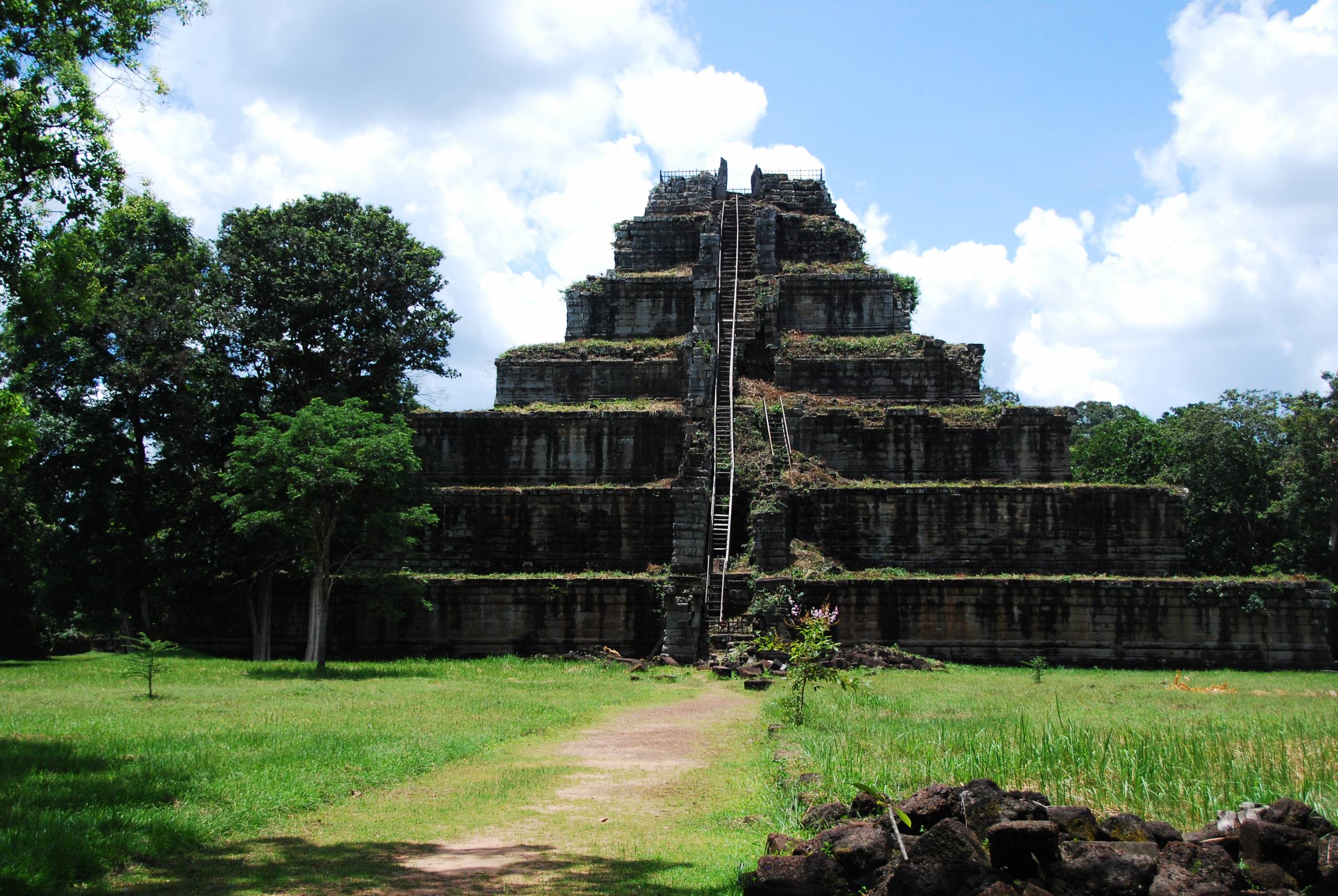
Explore the natural beauty and unique traditions of Koh Ker village, a hidden gem in the heart of Cambodia.
Between 928 AD and 944 AD, during the reigns of Jayavarman IV and Harshavarman II, the city of Koh Ker served as the capital of the Khmer Empire. Today, visitors can explore the dilapidated carved sandstone ruins that were once home to over 10,000 inhabitants and imagine the bustling hub that it once was.
The site, located around 120 km northeast of Siem Reap, boasts an unusual seven-tiered pyramid structure called Prang that stands at an impressive 36 meters high and dominates the lesser-known archaeological site that lies nestled in ever-encroaching jungle.
To enter the site, visitors pass through an imposing sandstone entrance pavilion and moss-covered ruins of two laterite towers. Along the eastern side are meditation or prayer “palaces” that were built for noble kings, while the temple complex Prasat Thom, complete with its moat, can be seen. The pyramid, situated on the western side, is believed to have been the state temple, and a wooden staircase with a handrail has been built to allow visitors to climb to all but the top tier.
The seventh tier is where a plinth originally supported a four-meter high linga honoring the Hindu deity Shiva. The views from the highest point are breathtaking, with forest stretching out as far as the eye can see.
Due to the remote and sparsely populated forested region, the surrounding areas have yet to be cleared of mines. This has resulted in only a dozen of the ancient city’s now forest-ravaged 184 monuments being accessible to visitors.
As a result, a visit to Koh Ker feels like a hidden secret, with fewer crowds and very little tourist infrastructure to cater for large groups. Visitors may only encounter a handful of others, allowing them to explore the crumbled and weather-beaten remains at their own pace.
Among the many smaller monuments in Koh Ker, Prasat Bram (literally translated as “five temples”) is a true highlight, consisting of five brick towers, two of which are completely overgrown by strangler figs.
How to get there
To visit Koh Ker, you can arrange a private car for a pleasant 2.5 hour drive from Siem Reap along decent roads. Along the way, you’ll pass by cashew and banana plantations, as well as rice fields, offering picturesque views. The Kulen mountain route can be easily combined with a visit to Koh Ker and Beng Mealea.
Upon arrival at the Koh Ker car park, you’ll find a selection of restaurants, drinks kiosks, and market stalls selling fresh coconut drinks and souvenirs. However, note that there are no restrooms available at the site.
When to visit Koh Ker
Morning visits to Koh Ker can be a good option for visitors who want to avoid the hot sun, as the pyramid itself and the climb up its tiers are not shaded by trees. If you plan to visit both Koh Ker and Beng Mealea, it’s recommended to visit Koh Ker first in the morning when it’s cooler, and then head to Beng Mealea around lunchtime when large tour groups are taking a break.
While Koh Ker is not usually crowded even during high season, visiting during the quieter months of May to November can provide an even more leisurely and peaceful experience.
Entrance fee
To enter Koh Ker, you can purchase tickets for $15 per adult, while children under 12 years old can enter for free. Tickets can be bought at the Beng Mealea ticket booth or online.
If you need to use the bathroom, there are good facilities available at both the ticket kiosk and the ticket checkpoint closer to Koh Ker. The checkpoint also has covered picnic benches, providing a comfortable spot to relax and take a break.
History of Koh Ker
Excavation work carried out in 2015 revealed that there was activity and settlement at Koh Ker as early as the 7th to 8th Centuries. The ancient city also had strategic importance due to its location along an important route that linked Angkor Wat with Wat Phu in Laos, taking in Beng Mealea and Preah Vihear along the way.
The area around Koh Ker was remote, heavily forested and comparatively dry, and so the inhabitants relied on an ambitious network of canals, water tanks, and a reservoir (baray) for their water supply. Jayavarman IV’s short reign saw an intense period of construction that resulted in the pyramid, 40 surrounding temples, and many other monuments. Inscriptions suggest that taxes for this construction were paid in rice.
The inhabitants of Koh Ker worshipped the Hindu God Shiva, and despite the country’s later shift to Buddhism, the Shiva lingas at Koh Ker somehow managed to evade orders for their demolition, possibly due to the remote location of the city.
Architecture
During the reign of Jayavarman IV, art and sculpture were highly valued and encouraged, resulting in the creation of numerous masterpieces at the Koh Ker site. However, after the site’s heyday, it was subjected to looting, resulting in the loss of its impressive sculptures. Some of these stolen art pieces have since been displayed in museums or private collections, but many remain missing.
Koh Ker was constructed using a combination of laterite, sandstone, and brick materials, which were readily available in the surrounding area. The high quality of the laterite and sandstone enabled large quantities to be quarried and transported with relative ease. The brick sanctuaries at Koh Ker remain in good condition to this day, thanks to the small and solid bricks used and the organic ‘mortar’ employed in their construction.
Some temples at Koh Ker had wooden roofs covered with tiles. Despite the passage of time, these structures have remained relatively intact, which is a testament to the quality of their construction.
A countryside visit to a nearby temple site can be the perfect way to spend an ideal day out. With a pleasant drive and the opportunity to combine it with other nearby temple sites, this location offers a unique experience for tourists who may have already seen their fair share of temples.
The site features an unusual pyramid structure and provides stunning views from the top that stand out from other sites in the area. Whether you’re a young child or an archaeologist at heart, this trip is sure to delight visitors of all ages.
Srah Srang
Visitors to this 10th century baray, or reservoir, are enchanted by its magical setting, especially when they catch a serene sunrise from its cross-shaped, laterite landing stage. As you take in the view of the baray, which has been partially flooded since the reign of King Rajendravarman II, two lion guardian statues keep a watchful eye. This peaceful and historic site is sure to leave a lasting impression on all who visit.
How to get there and when to visit?
Situated 1km south of the East Baray and to the east of Banteay Kdei, this terrace can be reached via steps from the road. The road is located at a lower level than the baray’s banks, providing visitors with a view across the water as they make their way up. This unique vantage point offers a glimpse into the stunning landscape and sets the tone for an unforgettable experience.
For those looking to avoid the crowds at Angkor Wat, a peaceful alternative is to visit Srah Srang at sunrise. This time of day is particularly popular, as visitors can enjoy a serene experience while taking in the beauty of the surrounding landscape. Whether you’re an early riser or simply seeking a quieter moment, a visit to Srah Srang at sunrise is sure to be a memorable one.
History
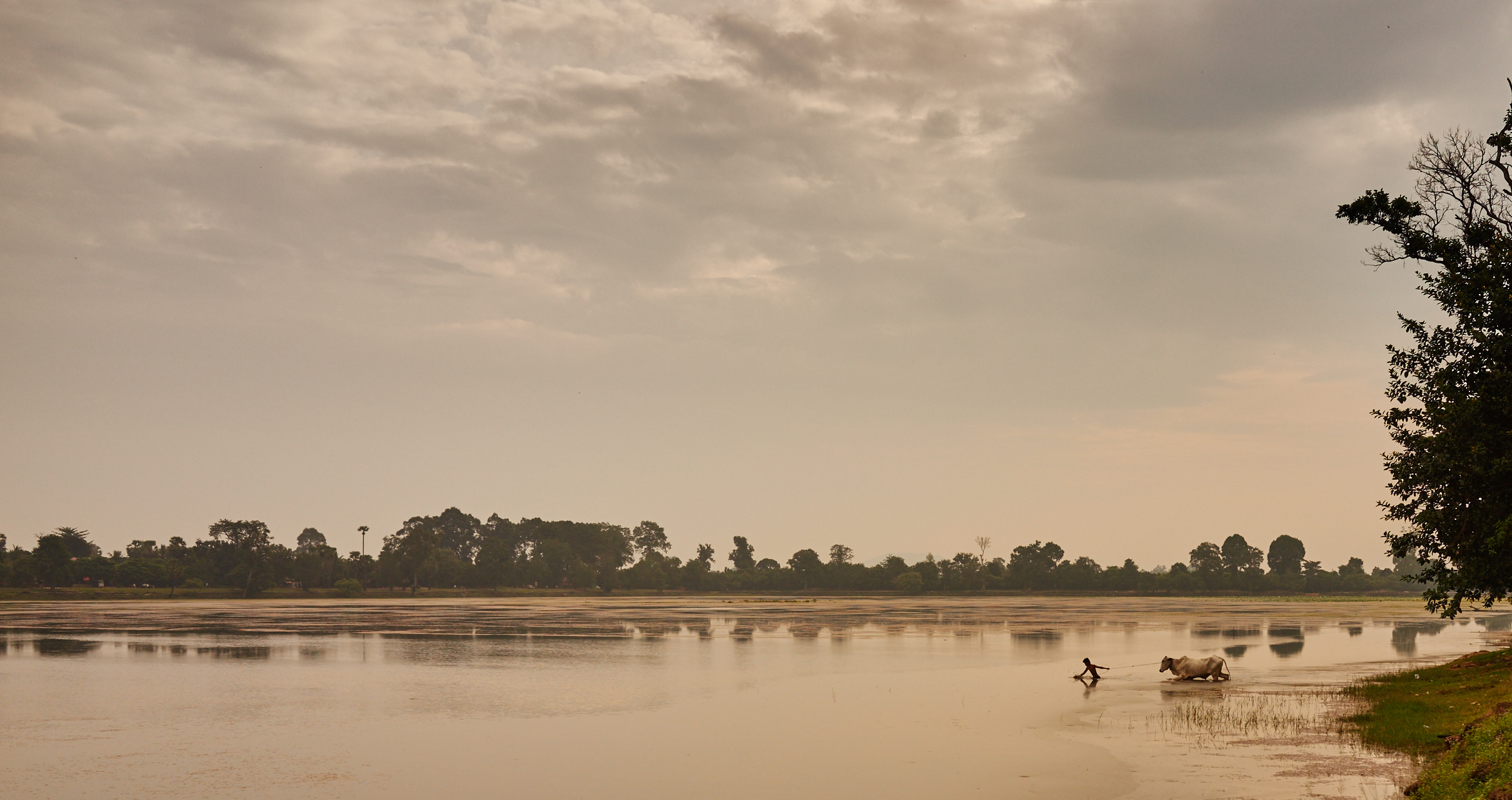
Experience the peace and tranquility of Srah Srang, a serene oasis in the midst of Cambodia’s ancient ruins
Despite its name suggesting that it was intended for royal bathing, inscriptions found at Srah Srang dating back to the mid-10th century suggest a more inclusive purpose – providing water “for the benefit of all creatures.” Interestingly, recent discoveries of stones similar to those used in the construction of East Mebon suggest that there may have been a temple on an artificial island in the center of the 700m x 300m reservoir.
In the 12th century, Jayavarman VII made changes to the structure by adding a terrace to the western side and lining the pond with sandstone. It’s believed that these alterations were made to compensate for the East Baray’s declining efficiency as a source of water due to sediment accumulation. As a result, Srah Srang became a convenient alternative for the local population.
Architecture
Srah Srang offers all the elements of a romantic setting, complete with lush greenery, a grand landing stage, and sweeping views across the water that reflect a beautiful sunrise or sunset. Two majestic lions flank serpent balustrades that lead down to the water from the platform, while a large garuda riding a three-headed serpent, along with other mythical creatures, rests on a nearby platform.
The Bayon-style architecture, favored by King Rajendravarman II and designed by his preferred architect, Kavindrarimathana, completes the picture. For those looking for a serene and enchanting escape, Srah Srang is not to be missed.
Banteay Kdei

Discover the intricate details of Banteay Kdei, a temple complex that dates back to the 12th century
Banteay Kdei offers a peaceful and quiet alternative to the often-crowded Angkorian ruins. Its name, which means “Citadel of Chambers,” is fitting; the ruins are a fascinating maze of chambers that are a delight to explore. In addition to serving as a Buddhist temple, these ruins have been home to an active monastery at various times since their construction in the 12th century, up until the 1960s.
Despite its historical significance, Banteay Kdei is often overlooked by the bustling Angkor tourism industry, which has allowed the ruins to become overgrown and seemingly forgotten. However, this solitude and mystery make it a hidden gem for explorers of the region. The tall trees that cast shade over the Buddhist bas-reliefs only add to the allure of this forgotten treasure, and visitors can easily spend many hours exploring its meandering design.
Location and How to Get There
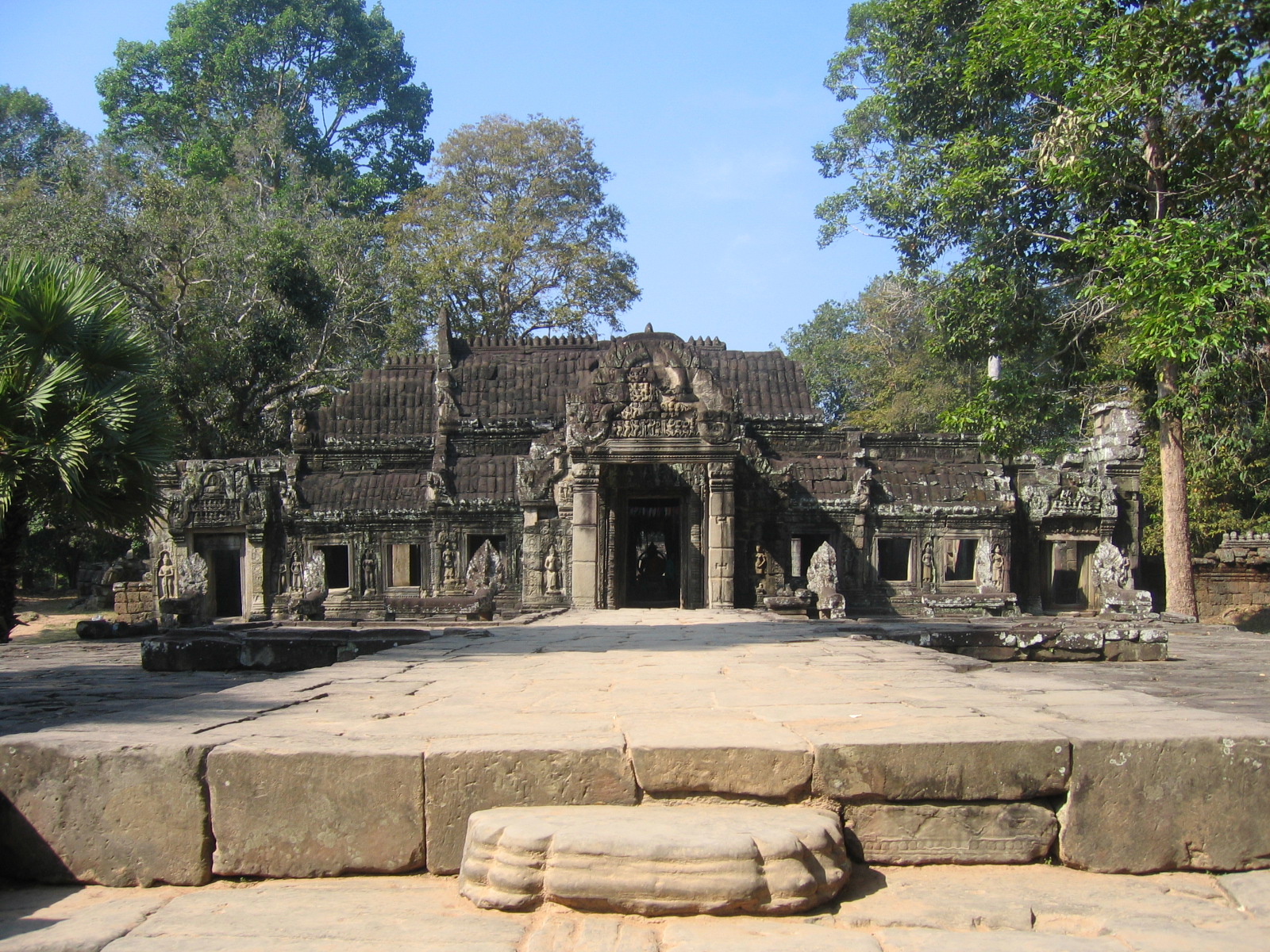
Step back in time at Banteay Kdei, and marvel at the engineering and artistic prowess of the Khmer Empire
To visit Banteay Kdei, visitors must have a temple pass as it is located within the Angkor Archaeological Park. It is part of the small circuit, a 17-kilometer loop that includes all of the “must-see” temples in the park.
Located opposite to the historic man-made reservoir of Srah Srang, Banteay Kdei is approximately 10.5 kilometers (6 miles) from Siem Reap. It can be reached by a 15-minute tuk-tuk ride or by bicycle, which takes about an hour. The small circuit is completely flat, making it a reasonable and enjoyable option for touring on a bicycle from Siem Reap city center.
Visitors should allot around 30-60 minutes to explore the fascinating set of ruins at Banteay Kdei. For more transportation options, contact us to get more details.
Why You Should Visit Banteay Kdei
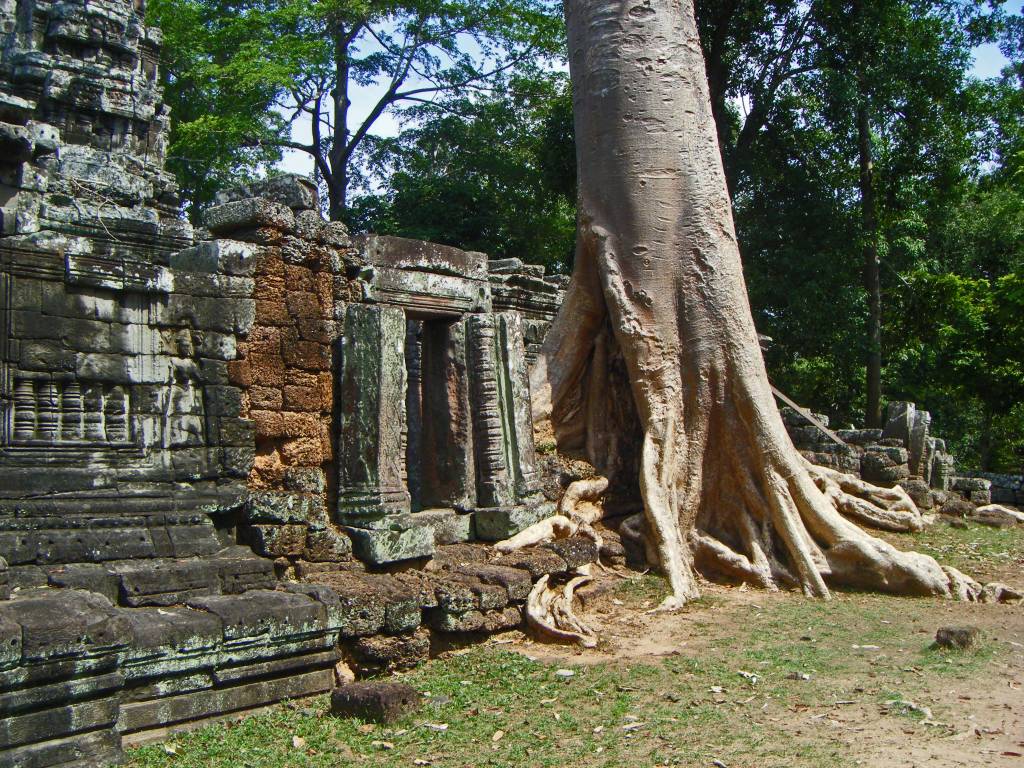
Discover the intricate details of Banteay Kdei, a temple complex that dates back to the 12th century
As previously mentioned, the serenity and lack of crowds at Banteay Kdei offer a refreshing contrast to the bustling Angkorian ruins. The experience of exploring the maze of chambers at this peaceful temple is a spiritual one that can’t be replicated when jostling with other tourists. Additionally, Banteay Kdei is an excellent location to witness the sunrise, along with its neighboring temple, Srah Srang.
Upon entering the temple, visitors are greeted by a Buddhist monk or nun guarding a small shrine near the entrance. It’s not necessary to donate or interact if you don’t wish to. The overgrown halls and courtyards at Banteay Kdei offer plenty of opportunities for photographs. To maximize your enjoyment of Angkor Park, starting with a sunrise tour of Banteay Kdei and then visiting the more popular temples later in the day when the crowds have thinned out is a wise strategy.
You may hear a loud chirping sound in the jungle surrounding the temple, which comes from the cicadas, and the shadowy corners of the temple are home to rare, colorful arachnids that make for excellent photographs.
History and Architecture
Banteay Kdei, constructed during the reign of Jayavarman VII in the late 12th and early 13th centuries, shares a similar architectural style to other famous temples in Angkor such as Bayon, Ta Prohm and Preah Khan. Despite being smaller in size, it is a noteworthy temple with a layout that includes three enclosures within an outer compound wall. The inner enclosure has galleries along its axis that lead to the main temple.
However, the temple’s construction was inferior and the use of poor grade sandstone is evident today in its deteriorated condition. Nevertheless, ongoing restoration work is taking place to bring the temple back to its original state. One unique aspect of Banteay Kdei’s design is its gates adorned with the same face towers or gopuras as Angkor Thom’s five gates.
Historians believe that the face towers represent both Jayavarman VII and the god Lokesvara or Avalokiteshvara. Additionally, like Ta Prohm, Banteay Kdei has a hall of dancers decorated with apsara dancer bas-reliefs and a seated Buddha that overlooks the corridor. Another highlight of the temple is the well-preserved devatas, which can be observed by looking up at the towers within the courtyard.
Pub Street
No trip to Siem Reap is complete without experiencing the vibrant nightlife of Pub Street, known as the party hub of Cambodia. This 100-meter stretch of road, officially called “Street 8,” comes to life as the sun sets, and is dotted with neon-lit clubs, bars, restaurants, and vendors, stretching from the Red Piano Restaurant to the Banana Leaf Restaurant.
Thanks to a recent renovation during the Covid pandemic, visitors can now enjoy an improved experience on Pub Street, complete with a new sewerage system to ensure comfort during rainy weather.
Located in the heart of Siem Reap near the stunning Siem Reap River and various markets, Pub Street is a popular destination for backpackers from around the world who gather to dance and party the night away. While it may not be as wild as Bangkok’s Khaosan Road, Pub Street offers plenty of excitement and fun. As night falls, the street is closed off to traffic, creating a safe and relaxing atmosphere for strolling, dancing, and letting loose.
With a wide range of culinary delights, from traditional Khmer dishes to Western favorites served by food trucks, and options like 75 cent draft beers and crispy insect snacks to try, there is never a dull moment on this lively street.
The History of Pub Street
Pub Street, the famous nightlife hub of Siem Reap, has humble beginnings. It started with just three restaurants on a small stretch of dirt road in the city center. The Angkor WHAT? Bar was the first to open in 1998, followed by the now-defunct Singaporean Asian Rooftop restaurant and Red Piano Restaurant in August 2000.
Temple Club and Le Tigre de Papier soon joined the scene. However, at that time, Pub Street was more known for its rats than tourists. It was not until around 2005 when the street was paved and became cleaner.
Following the success of Angelina Jolie’s movie “Tomb Raider,” which featured the breathtaking temples of Angkor, tourists began to flock to Siem Reap to experience Pub Street’s parties. The locals and travelers officially named the street “Pub Street” around 2008. Today, the party scene extends to two parallel alleys known as “The Lane,” located north of Pub Street, and “The Passage,” located south of Pub Street.
Pub Street Local Tips & Tricks
It is important to be aware of common scams in Siem Reap, including the milk scam mentioned above. Another common scam is the tuk-tuk scam, where drivers will offer to take you on a tour of the temples for a very low price, only to stop at a series of shops and restaurants where they receive a commission for bringing in tourists.
It is best to negotiate a fair price with the driver and make sure that you are clear about where you want to go and what you want to see before getting in the tuk-tuk. Additionally, be wary of pickpockets and bag snatchers, especially in crowded areas like markets and tourist attractions. Keep your belongings close and be mindful of your surroundings.
Finally, it is important to note that giving money to beggars can perpetuate the cycle of poverty and may not always be the best way to help those in need. Instead, consider supporting local non-profits and organizations that work to address systemic issues and provide sustainable solutions.
Key takeaways
Siem Reap, a highly favored destination among tourists in Cambodia, boasts a plethora of attractions in Siem Reap, ranging from historical temples and natural landscapes to cultural performances. Among the top experiences and tours, visitors can explore the largest religious monument in the world – Angkor Wat, discover the floating village of Kampong Phluk, and observe the Tonle Sap Lake, the biggest freshwater lake in Southeast Asia.
Additionally, visitors can appreciate the Kulen Waterfall and the 1000 Lingas, ancient engravings on the riverbed, and gain insight into Cambodian history and culture at the War Museum and Killing Fields. Furthermore, Siem Reap is a hub for vibrant nightlife with numerous night markets, pubs, and restaurants to choose from.
Top attractions in siem reap
Here are some of the most unforgettable places you must visit in Siem Reap:
- Angkor Wat: No visit to Siem Reap would be complete without witnessing the majesty of Angkor Wat, a UNESCO World Heritage Site and the largest religious monument in the world. Explore its intricate carvings, towering gopuras, and serene courtyards, and experience the magic of sunrise or sunset over the temple.
- Angkor Thom & Bayon Temple: Step back in time at Angkor Thom, the ancient walled city of the Khmer Empire. Explore the Bayon Temple, known for its enigmatic smiling faces, witness the grandeur of the Terrace of the Elephants, and wander through the ruins of the Royal Palace.
- Ta Prohm Temple: Embark on an adventure at the atmospheric Ta Prohm temple, where nature and architecture intertwine. Massive trees embrace the ruins, creating a captivating sight that has been featured in films like “Tomb Raider”.
- Banteay Srei: Nicknamed the “Lady Temple,” Banteay Srei is renowned for its intricate pink sandstone carvings and exquisite details. Enjoy the peaceful atmosphere and appreciate the craftsmanship of this architectural gem.
- Tonlé Sap Lake: Experience the unique floating villages of Tonlé Sap Lake, the largest freshwater lake in Southeast Asia. Learn about the local way of life, visit the flooded forest, and witness the vibrant birdlife.
- Angkor National Museum: Immerse yourself in the rich history and culture of Angkor at the Angkor National Museum. Discover fascinating artifacts, learn about the Khmer Empire, and gain a deeper understanding of Siem Reap’s heritage.
- Pub Street: As the sun sets, Siem Reap comes alive with the vibrant energy of Pub Street. Savor delicious food, sip on refreshing cocktails, and enjoy live music in this bustling hub of nightlife.
- Khmer Cooking Class: Unleash your inner chef and learn the secrets of authentic Khmer cuisine in a hands-on cooking class. Master essential dishes like Amok curry, Lok Lak, and Fish Amok, and enjoy the fruits of your labor with a delicious meal.
- Angkor Silk Farm: Learn about the fascinating process of silk making from silkworm to finished product at the Angkor Silk Farm. Witness the skilled artisans at work, observe the different stages of production, and purchase high-quality silk products as souvenirs.
Travel Tips before visiting Siem Reap.
If you are planning to visit Siem Reap, here are some final tips and recommendations to help you make the most of your trip:
Visa: Make sure you have a valid visa before arriving in Cambodia. You can apply for an e-visa online or get a visa on arrival at the airport.
Weather: The best time to visit Siem Reap is during the dry season (November to April), when the weather is mild and pleasant. However, this is also peak tourist season, so be prepared for crowds.
Dress code: When visiting temples and other religious sites, it is important to dress modestly and respectfully. Wear clothing that covers your shoulders and knees, and avoid wearing revealing clothing.
Transportation: Siem Reap has a variety of transportation options, including tuk-tuks, taxis, and rental bikes. Negotiate prices in advance to avoid being overcharged.
Money: Cambodia’s official currency is the Cambodian riel, but US dollars are widely accepted. It is recommended to carry a mix of both currencies.
Health: Make sure to drink bottled water and avoid street food to prevent getting sick. It is also a good idea to pack mosquito repellent and sunscreen.
Respect local customs: Cambodian people are known for their friendly and welcoming nature, so it is important to show respect and kindness towards them. Learn a few basic Khmer phrases to show your appreciation.
By following our tips and recommendations, you can have a safe and enjoyable trip to Siem Reap.

